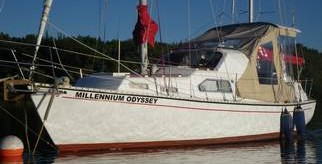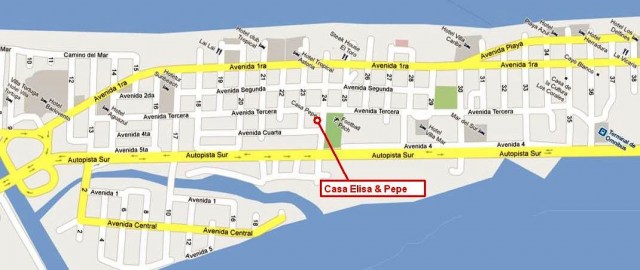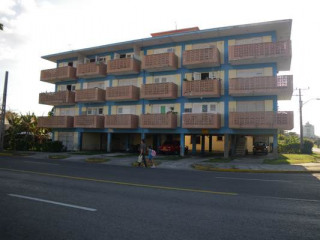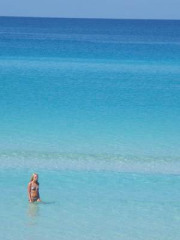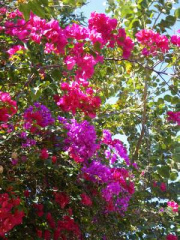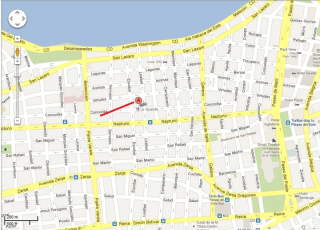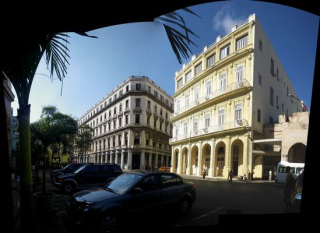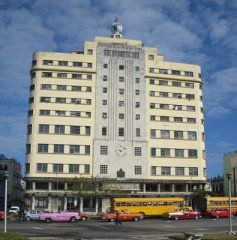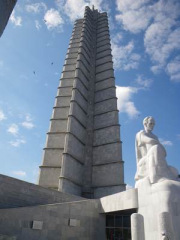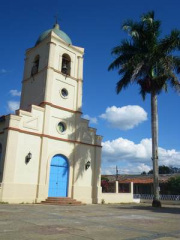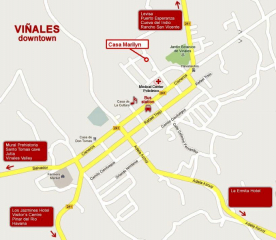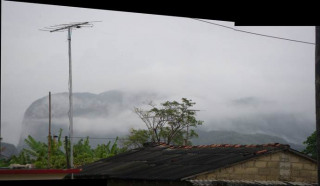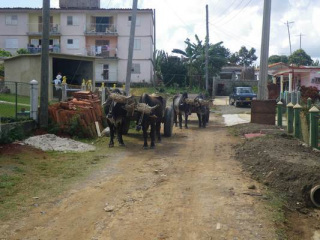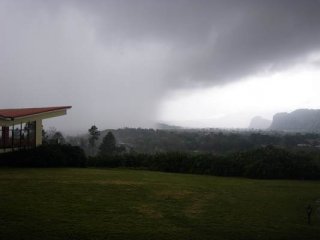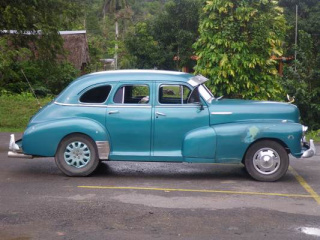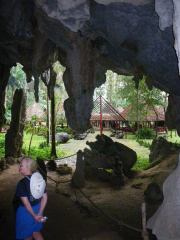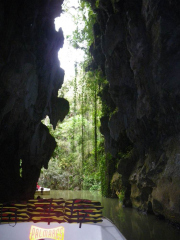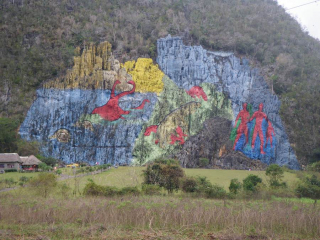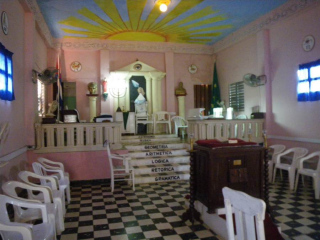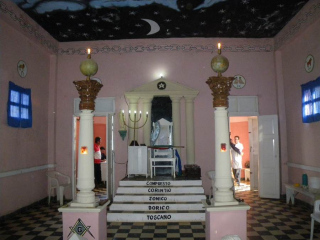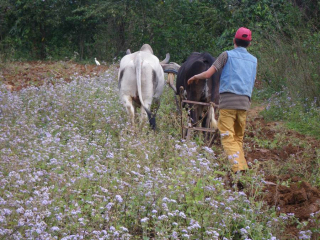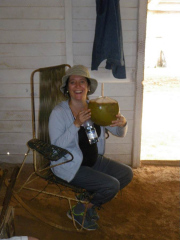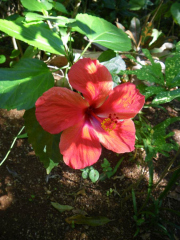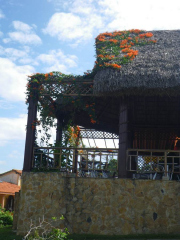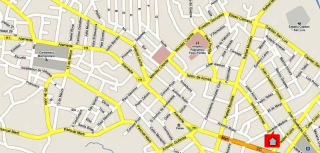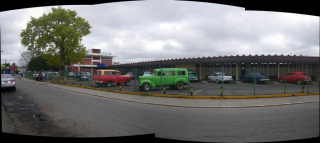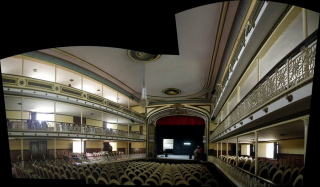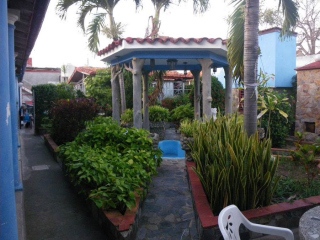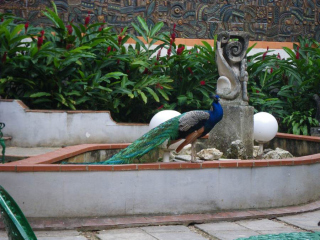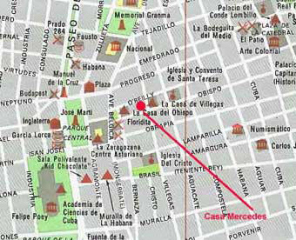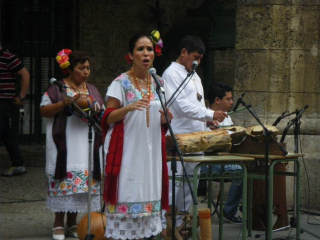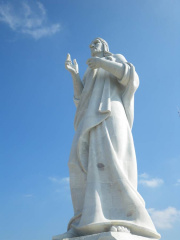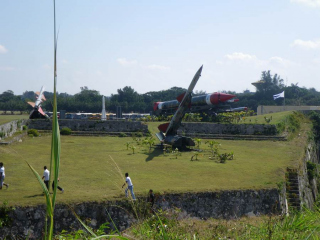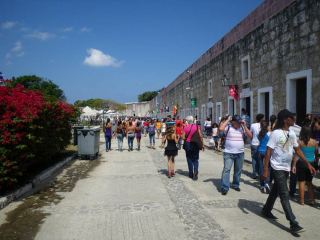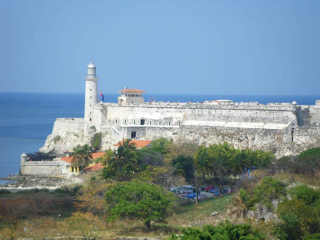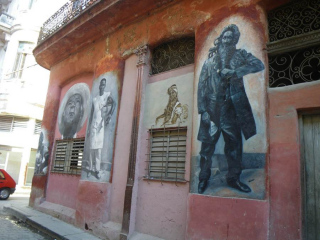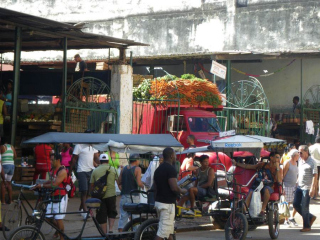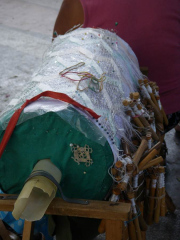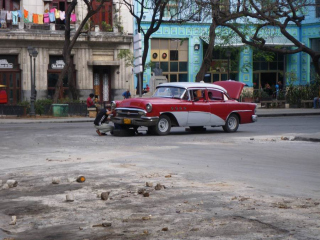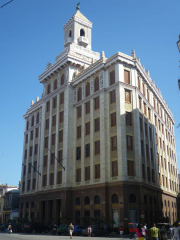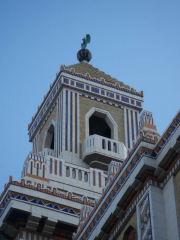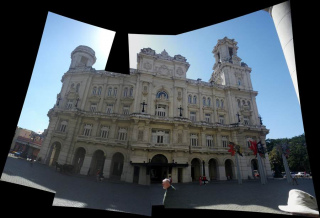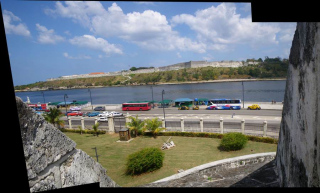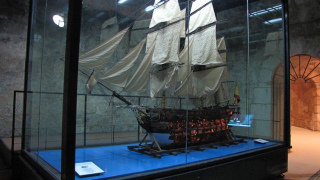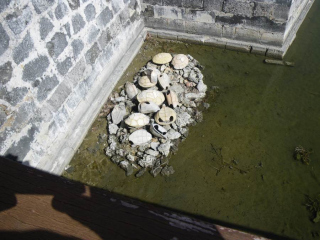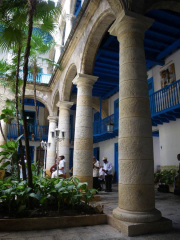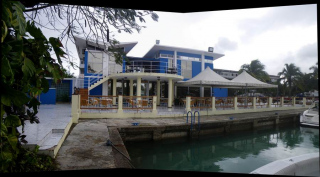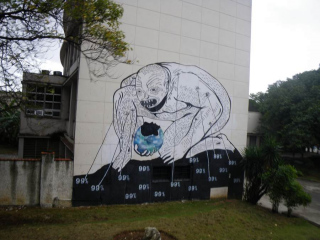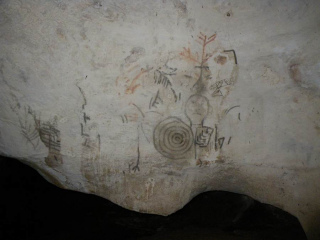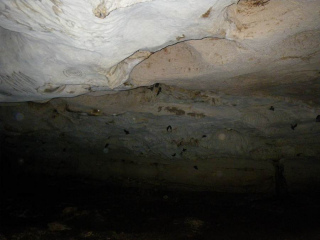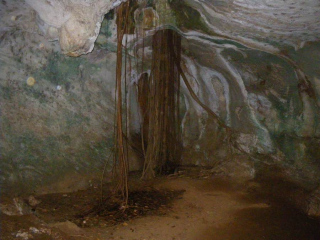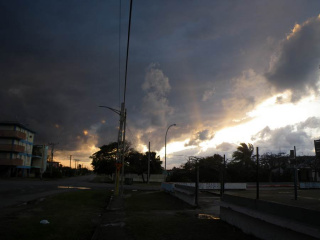2013 Our First Trip to Cuba
Feb 4 2013 – March 5 2013
February 4, 2013
We were saving several hundred dollars by traveling through Moncton Airport rather than Fredericton but that also meant that we had to drive to Moncton, spend a night in a hotel, and do something with our car for the month we were away. Even with the additional expenses of using Moncton it still worked out cheaper than flying out of Fredericton.
We were fortunate to have a couple of nephews in Moncton to call on. Bonnie’s nephew Brent and his wife Angela lives near Moncton and have space for our car. Unfortunately she took a bad fall on a patch of ice and wasn’t able to drive, and Brent was away. So we called on my nephew Craig to get us from Brent and Angela’s to the Super 8 near the Moncton airport. Brent and Angela promised to drop the car at the airport long term parking lot as close as was convenient to our return date and we would drive home from there. We were scheduled to arrive at 2355 on March 4 so it was too late to do anything but grab a room if the weather was bad, or drive home if the weather was good. We hear rumors that Westjet is considering bringing in a regional carrier to Fredericton, and if this is true, maybe prices will drop flying out of Fredericton so that the additional hassle of flying out of Moncton is not necessary. Even after all of the additional expenses of flying out of Moncton we figured we are up at least $200 on the price of tickets from Fredericton.
February 5, 2013
Flights to Varadero
Westjet
Depart Moncton
Depart Moncton 6:00 AM Flight 659 Arrive Toronto 7:25AM
Depart Toronto 9:55 AM Flight 2610 Arrive Varadero 1:30 PM
We stayed at:
Casa Particular Elisa and Pepe (Varadero)
Address:
Street 24 st.,
Nodarse Building,
3rd floor, Stair 306, Apartament #6
3rd Ave. & 4th Ave.,Varadero
Phone(s): +53 45 612632
Mobile +53 52648770
Cost(s):
$30 CUC per night
$4 CUC per person for breakfasts
$5 CUC per person for dinner (varies depending on what is ordered)
We were leaving at 6:00 a.m. so we had to be at the airport even earlier, but we had our boarding passes and were just traveling with carry-on luggage so that made our lives easier. We got there at 0430 and that was fine. I think I would have been more stressed if we had to get our boarding pass, the lineups were long when we got there. Having the boarding passes in hand and with just carry-on luggage we walked straight to security and our gate.
We had an easy flight, 2.5 hours to Toronto and then another 3.5 hour flight to Varadero. We had lots of time between flights in Toronto so the walk between gates was not an issue. Both were Westjet flights but we seemed to walk a good length of Terminal 3 to get from one to the other. We had enough time that I was able to go to the Tim Horton’s and get breakfast before our flight to Varadero.
When we got into Varadero the first thing we did was change cash over to the Convertible Pesos used by tourists in Cuba. We exchanged $1000 Canadian and the exchange cost us about three percent. From there were got a taxi to our casa. I think we paid a little too much, but what the heck. I was expecting to see the money exchange inside the airport arrival area but it is actually outside on the right from the arrivals door. If we were smart we would have teamed up with someone in the money changing line and split the taxi to Varadero.
One of the things that I did before we left was write out a detailed itinerary with much more info than I normally had. I had included normal things like detailed info about the dates and the casas with street addresses and phone numbers, but also included the Viazul bus schedule with all of the times between the place we were at and the place we were going. It had a map of where the casa was and where the bus station was. The idea being that if we ran into someone who had no English at all we could probably make our way by pointing at the dates and addresses or the bus schedule and with lots of waving and our VERY limited Spanish we would survive. We used that detailed itinerary a lot. Some of the Viazul bus station ticket agents had a little English, most didn’t have a lot. But with patience and pointing and a very little Spanish, we never had a problem getting what we needed. The taxi drivers were able to keep the itinerary in the front seat with them and refer to it as they traveled. Some of the taxi drivers had pretty limited English as well. They were able to read my notes about where we were going easily. Literacy rates are higher in Cuba than either Canada or the U.S.A., so I knew that the more I could give them in written form the better off we would be. Street addresses are street addresses in English or Spanish, phone numbers are phone numbers. The maps were less useful to the taxi drivers than the addresses but they were very helpful to us when we were walking around. We would get to the point where we knew we were within a couple blocks of the casa and we could dig out the map and find it.
We arrived at our first casa on our first trip to Cuba and had a bad stomach moment when we saw it. It didn’t look good. We walked up what we thought were the right stairs, they were dark, dusty, and very narrow, up three flights and I was getting more nervous with every flight. The stairs were marble and with the dust, were a little slippery. There was no light other than the sunlight reflected on the bottom steps. We knocked on the door and Elisa was there, we had arrived at the wrong door. The door to Elisa and Pepe’s apartment, not the casa entrance. But Elisa was very friendly and her English wasn’t great but we were able to communicate what we needed. Her English is much better than our Spanish. Her son Joan, studying civil engineering at the University of Matanzas does a lot of his school work in English and was able to fill in any blanks for us. Joan was interesting to talk to and we enjoyed his company. Elisa was a lawyer and now has the casa and raises her son Joan and her daughter Julien, in grade 10 in the pre-university program. Julien seemed a bit shy, we only saw her twice and that was only for a second or two.
Our room was spotless, clean simply does not describe it well enough. Everything looks new and the tiles on the floor don’t appear to even have a scratch on them. I felt guilty for wearing shoes in the room and took them off as soon as I could. The Super 8 in Moncton wasn’t in the same league as Casa de Elisa y Pepe.
Bonnie and I are what I call lazy travelers. We don’t try to fill every minute of every day of our trip to the max. When we have a travel day, that’s all that we plan on doing that day. So we when we arrived at a casa, we paid for all of our nights, all of our breakfasts and usually dinner for the two of us for the day that we arrived. We didn’t have to, the casa owners seemed to be fine doing it a day at a time, but I was happy to have our bill paid and be settled.
When Elisa filled out the paperwork she found out it was Bonnie’s birthday the day before.
Dinner that night was very good, we enjoyed it and went to bed early. We were tired after our day of travel. We normally slip easily into “boat-mode” when we are traveling which for us means up with the sun and down with the sun. When we are close to the equator that means we get a very good night sleep. Daylight lasts more or less 12 hours at the equator. I think Elisa and Pepe found it amusing that we crashed so early.

February 6, 2013
While we were waiting for our breakfast we watched the elementary kids being delivered to the school just down the street from the casa. The school uniforms were red on the bottom and white tops. School opens early for the parents to get to work, I think the first kids start arriving at 7.
The breakfast was special, Bonnie had a cake with a candle! I had a piece of cake. The breakfast consisted of lots of bread, lots of fruit, juice, coffee, fried eggs (although we did switch over to having boiled eggs when the amount of oil we were consuming started to disagree with us).
Our first task for the day was to find the Viazul bus station. Viazul is the tourist bus service that runs like clockwork all around the island, with modern buses and reliable service. The bus station on the map above is the Viazul bus station. We used them for all of our major trips between stops, with taxis between the bus station and the casas in Havana. We walked up to 4th , the road between the military barracks and the major highway, the Autopista Sur. When that road ran out, we walked along the path until we came to a car rental agency, across the street from the car rental agency is the Viazul bus station. There was a taxi driver trying to get us to hire him for a door to door service for $60. The bus cost us $10 each plus another $10 from the bus station to the casa, so $60 was twice the cost, something that if we had another couple with us we could consider doing. We bought the tickets and got reservations, two different things and getting a ticket didn’t necessarily get you a reservation, and you could get a reservation without a ticket.
Almost directly down from the bus station on First Ave is a stop for the Varadero Hop-on Hop-off bus. Tickets are purchased on the bus at $5CUC each. We decided to do a complete circuit on the bus and then decide where we would get off. There are lots of construction cranes and development on the resort end of the sand spit that is Varadero. In Varadero there are lots of casas. We saw the little Casa symbols everywhere.
We really enjoyed being on the top of the bus where we could see the blossoms at the top of the trees up close. The trees seemed to be covered in blossoms of every color.
After the ride on the bus we went looking for the Municipal Museum. We found the Infotur office and the woman explained our map was very old. She gave us a few maps that she had to help us find our way around. She was very nice and very helpful. We did find the Municipal Museum and it had some beautiful old furniture and plaques on a number of things. Unfortunately, most of it was in Spanish. This was true for most museums, we need more Spanish! Bonnie was better at reading than I was. The Museum had a presentation of a flora and fauna including a two headed shark! It was small and I doubt it survived long in the wild (if it was real at all). 
We walked out on the upper veranda of the Museum and admired the beautiful view, while watching carefully where we were stepping. It had that feeling that if you got too far off the mark you might go through! The view off of the veranda was incredible.

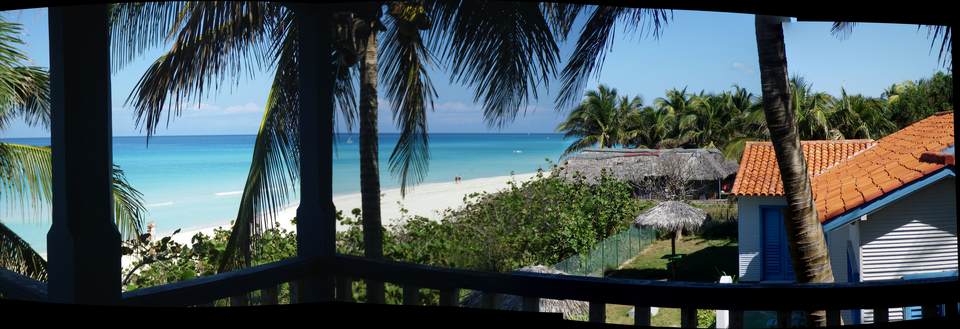

From the Museum we went to the little restaurant on the beach next door. The “Lifeguard” was the waiter for the patrons on the beach. He was tending the two ladies with considerable interest. It was a beautiful day and the scenery from the deck was a fantastic series of blue from the beach to the sky.
We walked down the beach and then returned along first ave. We were wondering about getting a SIMM card for my phone but decided not to bother. If we really needed it I would get one later.
The tourists from all the resorts were in town looking at the shops and filling up the town. We stepped into Parque Josone to do a little walk and explore. It is a beautiful little park and absolutely quiet. We almost had the park to ourselves. There is a little lake in the park and across the little bridge there is a restaurant with a cave. We didn’t eat there but we heard from a friend after we got back that the restaurant in the cave had the best Mojitos she tasted during her trip to Cuba. Susan and Richard were the people that told us about the Casas and inspired this trip.
The park was a great respite from the tourist hordes across the street. There were lots of interesting blossoms in the park and cars to see on the streets.
We went to dinner at Casa Miel (honey) a restaurant. The food was very good even if the waiter was very poor. The prices were reasonable too. Some of the restaurants we saw were expensive even for prices at home. Most restaurants had main courses for 6 – 9 cuc. We had Elisa call our next casa to say that we were coming. Making the call is something that the casa owners really appreciated.
February 7, 2013
We stayed at:
Casa Mirador de Concordia 457 Havana
Address:
concordia 457, belascoain y gervasio centro habana,
Havana 10200 habana 2, Cuba
Phone(s): +53 7 8625449
Email:
juliocea AT infomed DOT sld DOT cu
Cost(s):
$25 CUC per night
$3 CUC per person for breakfasts
$7 CUC per person for dinner
We had breakfast and walked over to the bus station. It was a long walk with the bags but doable. We did a little reading and waited for the bus. There were enough people for Viazul to put on an extra bus for just the people going to the airport. We can use that for our return trip to the airport. The Havana bus stops at the airport and costs only $6 CUC each.
The Viazul bus stopped at a number of places on the way through Havana to allow people to get off close to their hotel or casa. We decided that we would go to the bus station, buy the tickets to the next place, make the reservations and take a taxi to our casa, that way we would have everything set up for the way out of town. We wouldn’t have to worry about trying to find the station and getting to the station to do it later.
We got our tickets to Vinales from the small booth directly across the station from the arrivals gate and then went down to the entrance of the bus terminal where we made the reservations. The taxi from the bus terminal to the casa at 457 Concordia was $10 CUC. We ended up with a bit of a tour of the area as the taxi got lost and had to make a couple extra passes to find the street because of construction in the area.
Leticia, the owner of the casa, said that the area was safe, but to keep the door locked. Her English is pretty good. Alejandrio, her husband has very limited English. We ordered dinner at $7 CUC at 7 pm and went out for a walk out to the Malecon and all the way down to the fort. It wasn’t nearly as far as we thought it was. The area is very run down in places, but there are little shops, restaurants and businesses everywhere! The balcony of the casa looks out on the street and we could see a guy painting a mural between the buildings. We met the owner of a restaurant and he invited us in to look around and take pictures. The guy was still working on the mural when we toured the restaurant. Many more Spanish lessons are a must. We found a number of houses with masonic symbols on the door as we walked around.
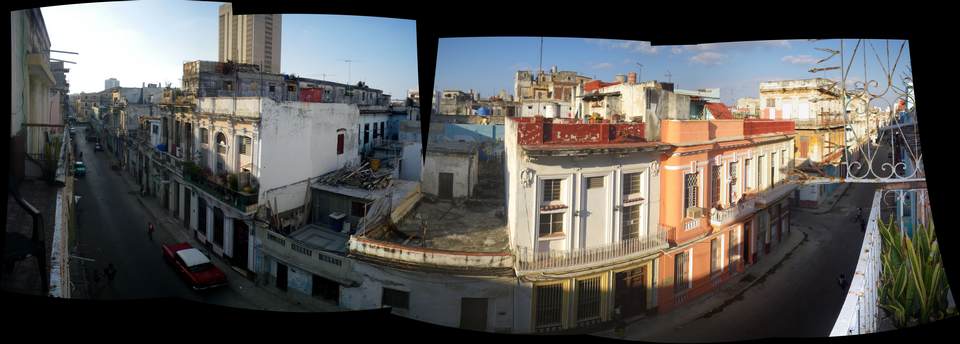
We have adopted the idea of the travel day and it seems to be working very well for us. On a travel day we don’t plan on doing anything else that day but travel. Have breakfast, go to the bus station, travel to the next bus station, buy the next set of tickets out of town, get the reservations, get a taxi to the casa, settle in, eat dinner at the casa and bed. Seems to work for us. Anything extra that we manage to get done is a pure bonus. Of course we do get a bonus every travel day, but not planning anything extra makes the day much less stressful. We were able to get to the Malecon and down to the fort then we worked our way back to the casa. The potcakes (free ranging stray dogs) are not as well fed in Havana as they are in Varadero. Many buildings are in very bad condition, a few are being restored, and are beautiful. A few cranes in Havana too. The government seems to be spending a lot on infrastructure and people seem pretty busy.
Sitting on the balcony in deck chairs you can buy at Canadian Tire, we watched the life on the streets below us. People seem very industrious, clean, and happy. Kids in elementary school have red and white school uniforms, middle school are tan pants/skirts, there are more police here, dressed better, on foot and bicycle patrols. Bonnie calls the area high density, people of all ages, babies to elderly. Lots of old American cars. All the newer cars are Geelys, Kias, and Hyundai. Ladas are old too. There are a few old Land Rovers, and a few newer ones too. Motor bikes and scooters are popular. Buses are mostly Yutang, there are lots of car logos I don’t recognize. Bonnie and I enjoy watching the life in the streets, our own street theater.
February 8, 2013
“Stay away from the Prado and the capitol!” we screamed. Our first day we hit our limit of hustlers in about an hour. “Cuban cigars cheap”, horse carriage rides, bike taxis, the list is endless. San Raphael is a pedestrian street that seems to be very much oriented to the locals. We had a couple of Mojitos at a street bar and the waiter fended off the hustlers, worth the price of the Mojitos by itself. We did a lot of browsing in the local shops and I’d be surprised if there is anything that the Cubans really want that they can’t get, including New Balance shoes made in Maine. The next time we come we will probably bring pencils and pens and skip the trinkets entirely. We walked for a few hours and then went back to the casa for an hour or so to recover from the hustlers.
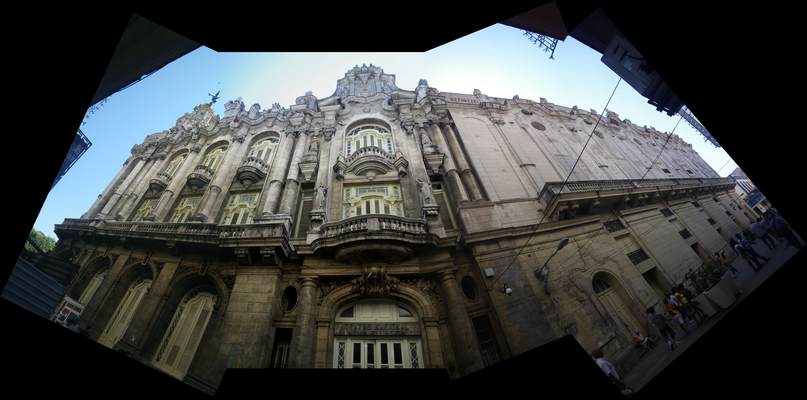
They were redoing the curbs and drains in the next block when we left in the morning and most of the block was done by our afternoon rest break. There seems to be a large population of LGBT individuals in the San Raphael shopping area. We saw an number of nice galleries and good art work and we will come shopping again on our return trip back to Havana.
The buildings in Havana are incredible. The capitol building looks exactly like the capitol building in the US, the International Art Gallery, the Bacardi Building, the National Theatre, all kinds of different architecture.
We went to dinner at the Notre de Bijeux restaurant around the corner from the casa. The mural was a little farther along and it was certainly an interesting place to visit. Unfortunately the food is better at the casa and a lot cheaper. The service was good but the cook is not as good as at our casa.
After dinner we sat out on the balcony and watched the street theatre. A car stopped across the street, it was a huge old American car, and like the red car in the picture showing the view from the balcony. It was full of flowers, the passenger seat was full, the back seat was full, the trunk was full. The driver got out and took several large bunches into the house and returned with a couple other people and they came out and got more flowers. After that the car disappeared and a while later the people came out and were off for their flower deliveries.
Kids of all ages were out to play in the street. The older kids looked after the younger ones. They played “ball”, a catcher (no glove), a batter (a guy with a stick that looked a little bigger than a broomstick), and the pitcher (pitching the plastic cap off of a water or pop bottle).
February 9, 2013
There was a spire of a church that we could see when we walked to the east end of our block. Today we were going to see if we could find it. We walked up and eventually found the cathedral. It is an impressive church but unfortunately closed during the week, so we could not see inside.
They were redoing the curbs and drains in the next block when we left in the morning and most of the block was done by our afternoon rest break. There seems to be a large population of LGBT individuals in the San Raphael shopping area. We saw an number of nice galleries and good art work and we will come shopping again on our return trip back to Havana.
The buildings in Havana are incredible. The capitol building looks exactly like the capitol building in the US, the International Art Gallery, the Bacardi Building, the National Theatre, all kinds of different architecture.
We went to dinner at the Notre de Bijeux restaurant around the corner from the casa. The mural was a little farther along and it was certainly an interesting place to visit. Unfortunately the food is better at the casa and a lot cheaper. The service was good but the cook is not as good as at our Casa.
After dinner we sat out on the balcony and watched the street theatre. A car stopped across the street, it was a huge old American car, and like the red car in the picture showing the view from the balcony. It was full of flowers, the passenger seat was full, the back seat was full, the trunk was full. The driver got out and took several large bunches into the house and returned with a couple other people and they came out and got more flowers. After that the car disappeared and a while later the people came out and were off for their flower deliveries.
Kids of all ages were out to play in the street. The older kids looked after the younger ones. They played “ball”, a catcher (no glove), a batter (a guy with a stick that looked a little bigger than a broomstick), and the pitcher (pitching the plastic cap off of a water or pop bottle).
February 9, 2013
There was a spire of a church that we could see when we walked to the east end of our block. Today we were going to see if we could find it. We walked up and eventually found the cathedral. It is an impressive church but unfortunately closed during the week, so we could not see inside.
We continued down the block and crossed to the square and looked across the street and there was a tall building with a globe on the top. On top of the globe was a Masonic Compass and Square, the Grand Lodge of Cuba. I had go over for a look so Bonnie and I made our way over and there were a number of people there. I introduced myself as a mason to an old gentlemen and he didn’t know much English and pointed over to a guy that was just coming in. He turned out to be a District Deputy Grand Master for the Havana area and a 33 degree Scottish Rite. He told me there were lodge meetings the week we were going to be back in Havana and to try to make it if I could.
We walked to the Jose Marti Memorial, a large tower (the trip to the top of the tower is closed for renovations) We spent a fair amount of time walking around the base and taking pictures. We would have paid the 5 CUC to get to the top. The view would have been spectacular. Spanish really is needed to get much of anything from the Cuban museums. Bonnie and I are both interested in learning Spanish.
We walked the route in the Lonely Planet guide for central Havana to see the Avenue of the Presidents, the British Embassy and a lot of really neat architecture.
One of the things we started to enjoy was returning to the casa in the early afternoon and watch the Cuban life as the people lived. Kids coming home from school in their uniforms, red for elementary, brown or beige for middle, blue for seniors. They change and come out into the street to play. The older kids watch out for the younger ones.
Lots of street theatre. The casa owner Leticia is a better cook than the chef at the Notre de Bijeux and his meal cost double. We found a nice little restaurant one street up and toward the capitol. I forgot to write down the name. Bonnie has hit her salt tolerance and was not feeling well. We had a vegetarian pizza and a calbasa (pepperoni) pizza, I ate most of mine and Bonnie had a piece of hers but she went home and was sick. The next day I hit my grease tolerance I wasn’t good. We both recovered and but were sore the next day. We didn’t do much but walk the Malecon. We ate at the same place that night and split a meal, 4 CUC and 2 for drinks for two people and we had plenty. At this point we started changing how we ordered in restaurants. We start ordering one meal and share it, if we are still hungry we order another meal. Rarely do we ever have to order a second course. Sometimes we add a course by having a coffee and splitting a dessert.
Our room in the casa was the first room I’ve ever been in that was taller than it was in width or breadth. It was a weird optical illusion to lay down on the bed and look up. The room wasn’t as hot as I expected it to be. The center of the house was an air plenum from the bottom floors up and out to the roof at our level. The air movement with the open windows seem to keep the room reasonably cool. We did use the fan but the room got too cool and we had to turn it off.
Our only other complaint about the casa was the dog barking at night, the dog belonged to one of the other tenants of the building below us.
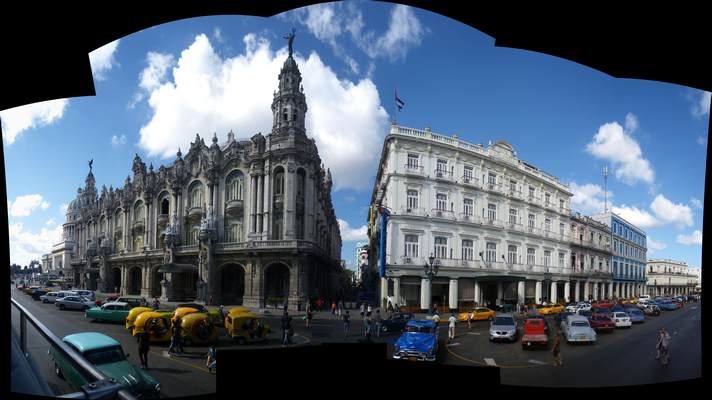
We did a recovery day by doing a ride on the hop-on hop-off bus. We took it on the full loop and got a chance to see the Cemetery from the bus. It is a HUGE cemetery with lots of white marble everywhere.
After our bus day, we then had a lazy day, with a horse buggy tour of old Havana. We found that the official historical guides were pretty good and made sure that English tourists got a guide that spoke good English. We met a good guide called Vincent (Buggy #29) whose English was pretty good and he offered us a tour. We were on our way to get cash so we backed away.
We did a fairly accurate calculation at what we needed for cash to get back to Havana and did a run to the Cadesca money exchange on Obispo. We stopped at another bank that was mostly populated by locals and they told us that it was not for people with CUCs. True or not we don’t know but we headed over to Obispo. I figured that with the money we had plus about a $1000 CUC we would probably have all we needed. Before we left Canada we put $1500 onto our ScotiaBank visa so that we would have the money sitting in our account when we needed to do a cash advance. Having the cash sitting there before getting the advance meant that we did not get charged any fees for taking money out. They don’t allow two at the teller at once so I went in and Bonnie waited outside. When I asked for $1000 CUC the teller’s eyes bugged out and the two tellers beside her had to come over to approve the transaction. It was a little over her limit apparently. I also asked for it in $20s, about the largest bill the locals can deal with. It would probably be better to do smaller withdrawals but it was unclear to me if we could get cash in either Vinales or Pinar del Rio. There were two banks in Vinales but it was not clear to me that either one could do a cash advance on our Visa card. I started carrying our stash in the money belt with our passports. Unlike Elisa and Pepe, this casa does not have a safe in the room.
We went to the bar next door and I slipped into the washroom to put the cash in the money belt. One of the things that is a little different than we are used to is the washroom attendants. The attendants keep the washrooms clean and provide you with toilet paper when you enter. The guide says .05 to .10 is a normal tip. We were able to gather a small amount of coins by buying water etc. Havana is not a place to drink the water, the whole of Cuba is a don’t drink the water kind of place.
We got the cash and went back to Parque Central and another historical guide “horse and buggy” wanted to take us out but his English wasn’t good so we asked about Vincent and the guided called and said he was on a tour. We waited and only a few people pestered us. Mostly older women, one hit Bonnie on the arm for saying no, Bonnie got called bad names, we might not know the words in Spanish but the body language said it all. The rudest of the pesky people are the old women.
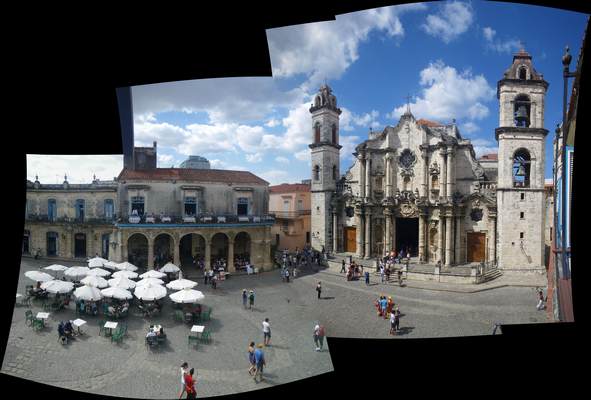
Vincent showed us around the old town and there are lots of stuff for us to look at when we get back to old Havana. We had Leticia call our next casa and tell the owner that we were coming.
February 13, 2013
We stayed at:
Casa de Marilyn
Address:
Street 1a. A #4B / A & B ,Vinales
Phone(s): +53 53373972
Email:
casamarilyn AT correodecuba DOT cu
Cost(s):
$20 CUC per night
$4 CUC per person for breakfasts
$7 CUC per person for dinner
We got Alejandrio, Leticia’s husband to take us to the Viazul bus station in the morning 6 CUC! The driver made us put our carry-on bags in the basement of the bus and I was glad all of our valuables were in Bonnie’s bag or my money belt. It was a nice trip to Vinales, the bus stopped at La Terraces in the National Park for a break. We stayed on the bus but that was a mistake we should have gone for a coffee.
We were in Vinales and met by Marilyn with a sign “Mike McDonald”, close enough. Practically every house in Vinales is a casa and there were lots of casa owners (a dozen or so at least) with signs for people another dozen or so with signs advertizing for a casa.
We settled into Marilyn’s paid for our time there and our breakfasts and had dinner with her. The food was pretty good. The guide book told us that Vinales had some of the best cooking in the country and you should eat in your casa. Marilyn mades us a “deal” that if we ate our dinners in her casa the whole time we were here she would charge us $7 CUC instead of $8 CUC. Her food was a little salty and had a lot less fat than anywhere we had eaten yet so we were happy to bite on the deal. We also asked for boiled eggs rather than fried to reduce the fat even more.
February 14, 2013
Our first day was greeted by a cold front. The rain and clouds in the hill were pretty. We talked to Marilyn about her “tours”. Her husband Adel runs a taxi and does the tour at the same rate or a little better than the buses. She also has a friend that does a walking tour as well as a friend that gives Spanish lessons.
We found the Masonic Hall on the main street just down from the bus station. “Damien @ 9am” as the sign says. Sunday at 9 am, I’m going to try.
We walked out of town in both directions and even a few places in the middle. The guide book says that there are 27000 people but I have a hard time believing it. Marilyn says there are about 7000 and the rest are in the surrounding area.
There is a lot of farming in the area as well as the free range life stock, chickens and the occasional small pig are on our street. I was awoken in the night by a rooster, in the silence of the night you could hear the roosters for a long way. I would listen and hear the one beside us crow and then when he was done the next one to the east would crow, and then the next one to the east of him, and so on and so on until you could barely hear the last one then the crowing came back from the east and the rooster beside us would crow as the wave swept to the west. Back and forth it would go a few times before it was decided it was too early and they went to sleep again. Bonnie would awake, roll over and sleep again, she is a farm girl. I’d listen to the wave and find it strangely comforting, nothing was moving in the village to disrupt the rhythm.
Apparently the men are into “stupid” cock-fighting. We have maintained our boat-mode early to bed early to rise. I think our Cuban hosts find it funny that we retire so early. Leticia had told Marilyn that we go to bed very early!
When we got home for our noon sit, there were two teams of oxen (Bonnie said they were Brahmin bulls) delivering a load of crushed rock and sand for cement. Marilyn and Adel are building another room for their casa. We have been disappointed in the birds we have seen, so far just a white egret, vultures, English sparrows, and a small green finch so far.
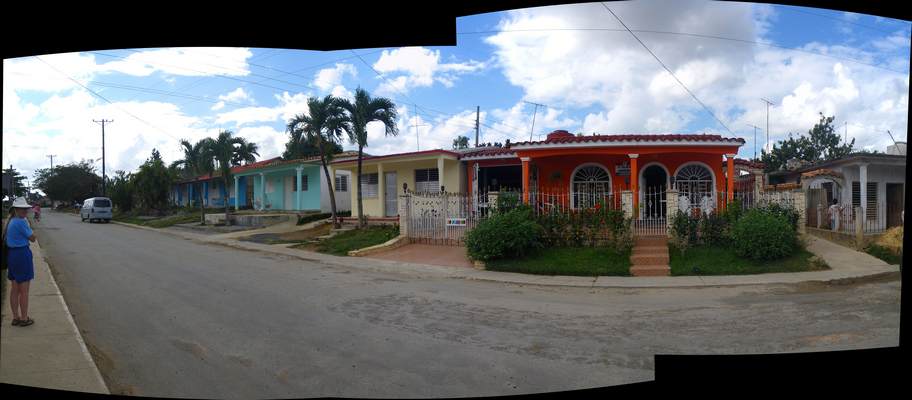
February 15, 2013

A three day cold front with more rain than we have ever seen in the Caribbean anywhere. In the morning we walked up the hill to try and find La Ermita, a hotel perched up high on the hill that we were told would allow us to use their facilities for a small fee if we wanted to use the pool or we could just eat at the restaurant. On our first try we missed and climbed up what turned out to be a farm road hoping for a cross road to connect to the road up to La Ermita. By the time we got high enough to find out, there wasn’t one, but the view was spectacular. We always have the best times when we get lost.
We walked to the other side of town and found the road to the La Ermita and the walk up gave us wonderful views of the valley. Definitely worth walking up to the La Emrita just for the views. We had two Cuban coffees (Marilyn’s is better!), while we were drinking the coffee the whole valley was swept by a rain cloud. We took a movie of the valley disappearing. We stay put and drank our coffee. I got to watch a few minutes of the next Harry Potter movie in spanish. The rain cleared, leaving a nice fresh smell and the sky clear of automobile smell. The walk down was very pleasant, we made it down to the casa in time to watch and wait out another shower sweep the valley. We walked down to the botanical garden and did a quick start of a look before we had to retreat to cover as another drenching rain passed over. We waited out most of it but got wet going back to the casa.
So far for dinner at Marilyn’s we had chicken drumsticks, red snapper (provided by Marilyn’s father), as well as lobster tails. We normally don’t like the lobster from the warm waters of the Caribbean, we find it rather dry. But the sauce that it was cooked in helped the dryness and it was the best we have ever had anywhere. Meals have been soup with white rice, a plate of vegetables (cucumbers, tomatoes, green beans, and sweet red peppers as a garnish), a fruit dish (bananas, mango, pineapple, and guava), fried plantain (Marilyn was surprised and pleased to find out that Bonnie especially loves the plantain), and then a meat dish. The food is very good, Marilyn was worried about repeating the dishes as we were staying for seven days but we were happy.
February 16, 2013
The weather looked better but still not good. We delayed our car tour so Adel could do cement foundation work on the new room. He had friends arranged to come over to help so the next day I think he was happy to sit while we toured. We drove around in the old 1948 Chev. No guages worked that I could see, including the speedometer. When I get into a car I tend to lean back against the seat to pull my legs in, not a good idea, gentle on the old car. I was afraid that if I did it again, Adel and I would have been laying flat in the back seat. The engine in the old car was replaced by a Mercedes-Benz diesel “two times rebuilt” for $2000 cuc. That’s a lot of money.
Adel took us to a couple of places not on the regular “Vinales tour” available from the Infotour booth as well as all of the places on the tour. We stopped at the Palenque de los Cimarrones, also called the Cueva de los Cimarrones. He asked if he could pick up at the end of the service road but I thought it would be nice to walk out. I heard that it was 800 meters, Bonnie heard 300 meters, Bonnie was closer to being right. The cave was nothing special, there were a few draperies but what was interesting every once in a while there was a seam of granite with quartz viens, the magotes are not pure limestone by any means. They had crafted and painted a number of snakes on the limestone and it was cave itself was not overly impressive. Our ankles were covered in little black biting insects when we emerged from the cave, the next day Bonnie’s ankles were covered in welts. Mine showed bites but Bonnie reacts to the bugs in the south much worse than I do. I react much more to the bugs in the north than she does.
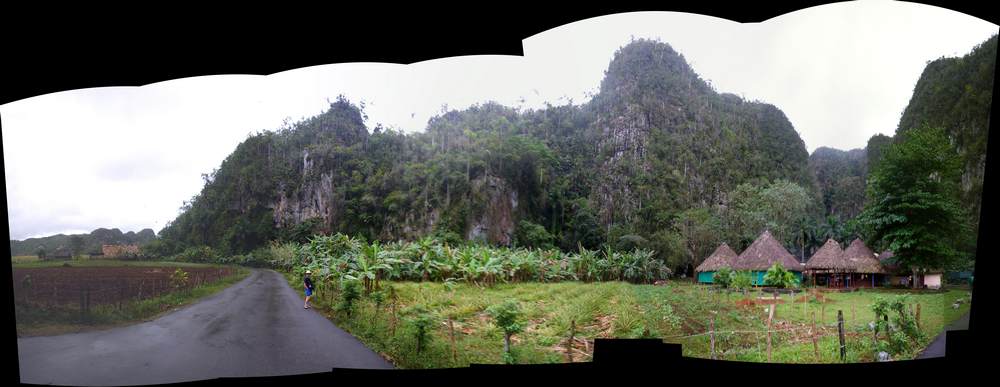
The service road was worth the admission. It was flat so there was was no strain walking out, the views were special. We enjoyed our walk back to the car. The “slave village” tucked into the corner of the hill with the hills around it were beautiful. We enjoyed the walk back to the car by the service road much more than the walk through the cave, no bugs either.
We went to the Cueva del Indio. There is a walk through the cave that has some nice cave decorations, bacon, draperies, ribbon, stalactites and stalagmites, a bit of popcorn, but no straws that I could see. You could go so far and then there was a boat that will take you the rest of the way through the cave. There is an underground river that appears from one end of the cave, and flows out the other side. The guide says that it is about 2 to 6 meters deep. He takes you up about 500 meters and turns around. He says it goes about another kilometer but “no lights”. On the return trip, he points out a number of formations, “seahorse”, “snake”, “skull”. I took quite a few photos and the colors were better than under the florescent lights. The florescent lights may have something to do with the subdued colors. From the Cueva del Indio we went to the prehistoric wall mural. The 120-metre-long outdoor mural was painted between 1961 and 1966 that depicts prehistoric life from dinosaurs to man. Adel wasn’t sure it was worth going all the way to the mural, you could see it from the road and if you get too close you can’t see it, and they charge you! All that is there is a canteen. I got out and took a few pictures, and we turned around.
We came by the botanical garden, but we didn’t want to waste “tour time” by going in, it is a short walk from the casa and we would rather have extra time to tour it. Adel’s english is not as good as Marilyn’s but I was able to get answers to most of my questions.
We went to the tobacco farm and they had four different sizes of cigars packed on site. Bonnie couldn’t think about how we could get them home with no protective packaging. We were thinking about cutting a large water bottle in half and putting the cigars inside. Since there are no labels on the cigars we weren’t sure about the rules for exporting them either. The next time we go I might take a food saver box and use it for protection.

Adel took us to the farm a the National Park, Casa de Confianza, and the food gardens and views were incredible. Adel showed Bonnie the difference between a plantain and a banana.
The bbinnvinales.com rep was apparently here and left us a CD as a gift. Marilyn and Adel gave us a bottle of La Occidental Guayabita del Pinar (40 percent alcohol version). It is made from a “dwarf guava” berry that only exists in the Pinar del Rio area. We are planning on staying in Pinar del Rio and supposedly not exported. They said is was because we were saying more than 4, or 6 days at their casa. We were just about to head to the botanical gardens when the real front finally arrived. The rain poured from the sky, the wind clocked north and the temperature dropped like a stone, sweater and long pants! Every time Bonnie mentions the botanical gardens it rains!
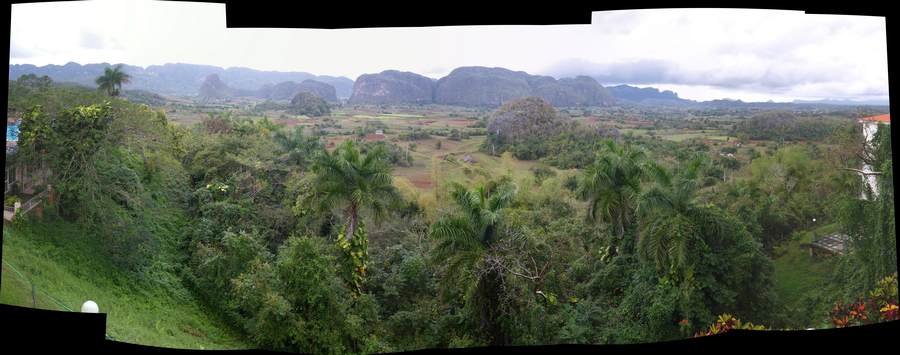
We spent the afternoon in long pants and sweatshirts and the mosquitos have come in from the cold at dusk. We were outside just before our supper and it looked like it was clearing from the west. I’m hoping the winds will clock and the sky will clear for tomorrow. After three days of rain, I’m ready for sunny and warm now. Florida must be freezing and Georgetown will be hammered with this front. We are about 130 miles south of Key west.
Vinales is living the 100 mile diet or pretty close. The rice patties we saw were well within 100 miles away, and the fish and lobster we had might be 25 miles the rest are delivered by horse and cart, 10 miles maybe. Incredible agriculture and the food tastes great.
One of the things that we have been struck by since being here is the commerce on the street. Pies, pastries, cakes, and all kinds of food being delivered by people calling their wares. Everyday we see vegetable dealers, fruit dealers, and bakers walking up and down the street calling for customers, sometimes by voice, sometimes by a distinctive horn, electronic or natural. Food is plentiful and the fruit is very high quality. Some of the peppers looked a little small, but the most part the food is unspiced but very tasty. Marilyn has laid off the salt completely. The soft boiled eggs in the morning are nice and it reduces the fat load too.
February 17 2013
We had breakfast and I went to lodge. There were 34 members, master masons sat in the east with the WM, Fellowcraft in the SW and Entered Apprentices in the NE. The lodge itself was set up more like it is in the Scottish Rite, than ours. The sign of fidelity was closer to our NFLD members than what we use in our lodge. Late comers are greeted differently. There were lot of gray haired guys but the officers were mostly young, the WM was in his early 30s, the “First Vigilante” was in his 20s, and the “Second Vigilante” was in his 20s, 5 Eas, and 4 FC.
They pass two collections the alms man, a bag, and the one for the lodge, a wooden house. I put a 20 CUC into the alms mans. The Lodge is much fancier than ours. I have a few pics. The Second Vigilante takes three steps up onto the platform where he sits, the First Vigilante has five, the WM has 5 up to a platform where the Masters have seats and then up two more for WM.
The ceiling over the WM is painted to be a rising sun, the First Vigilante has the moon and the stars. It was a privilege to attend the lodge and I would love to attend another. They seemed happy to have a visitor.
After I got back I changed and we went for a walking tour with Francesco. (He was one of the guys working with Adel pouring cement two days before). We teamed up with two Argentinian couples (one was pregnant) and did the all day walking tour (10:30 to 5:30), it was a long day. I was ready to be done for the day, the pregnant lady said “Thank you GOD!” when we got to the end of the road to her casa. I wasn’t much better.
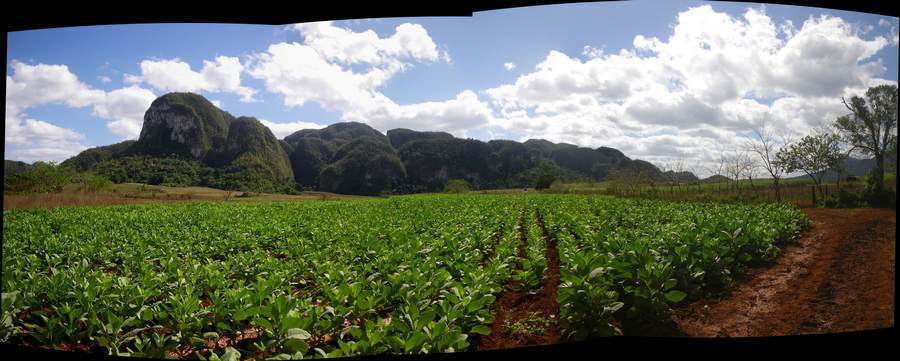
We walked into the next valley where no one was allowed to live. The valley drains through a cave and a hurricane dumped enough rain that when the cave plugged, the valley filled and all of the people and animals in the valley at the time drowned. Since then no one is allowed to live in the valley.
We had a coco-loco (chop the end off of a fresh coconut, pour in rum and honey and shake), it was not a retry for me.
The tobacco farmer rolled a cigar for us while I videoed him. The top of the tobacco plant, the crown, makes the best tobacco, the Coheba are made from the top leaves, next are the Monte Cristo, then the Romeo and Juliet, the trinidads, and the Pategas, the rest of the plant is chopped up to make cigarettes. Never buy a hard cigar, they should be soft. The ash should be 2 cm long when a proper cigar burns. The tobacco leaves are hung in the drying sheds and then fermented for 45 days to bring out the flavor.
We walked further down the valley to the cave. It is 14km long and we discovered that the difference between a good cave and a bad cave is a $5 flashlight.
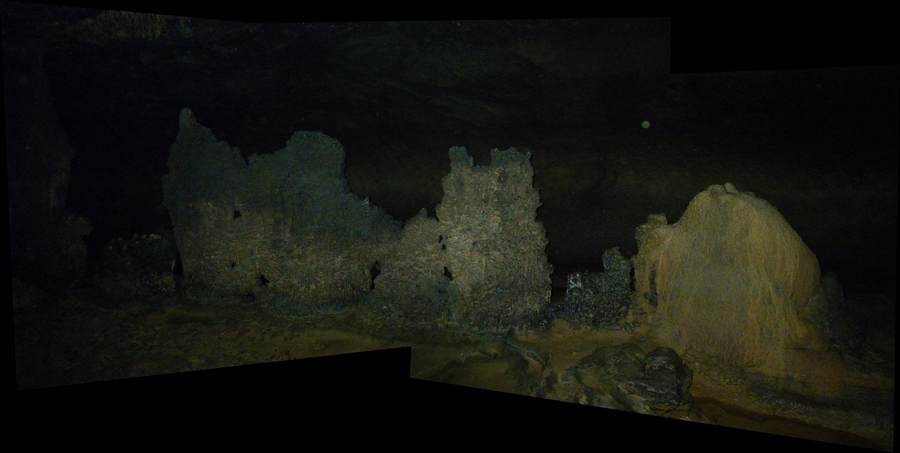
I took pictures of nothing but blackness, and ended up with several nice pictures of formations right beside us.
The valley has beautiful red soil that drains pretty well. They grow mais with beans so that the bugs attack the mais and leave the beans alone. The mais get fed to the cattle. He showed us all kinds of plants, good for purgative(enema), good for infection in the eyes, good for kidney stones, … The Argentinian couples tried to translate for us when Francesco ran out of words, but Francesco did a pretty good job on his own. The tour was $15 CUC each and it was a long walk Bonnie and I were hungry and ready for bed.
February 18, 2013
We were calculating money today and I made a couple more mistakes, silly mistakes I just shouldn’t be making. Nothing serious but annoying. I didn’t do a two times the breakfasts but we made money on using Marilyn’s services (and Adel’s), dinners were cheaper than budgeted, and the Cueva de Saint Thomas was closed with no opening date known. We are still thinking about a car trip to the beach but at $40-$50 we aren’t beach people.
We did a trip to the botanical gardens and were successful on our third try. The botanical gardens have been in the same family for over 100 years and the entrance is by donation. There are lots of interesting plans. Starfruit were hanging everywhere, cocoa pods, papaya, chenille (some of the best we have ever seen) lots of beautiful plants. Bonnie recognized more of them than I did, she is the plant person. Lots of beautiful things to see. The botanical garden was a wonder to walk around. Star fruit dripping from the trees. Tulip trees in full blossom. Too many plants to list. Unfortunately there is little to no documentation on what plants were what. We knew a number of the plants from other trips to different parts of the Caribbean. We were told the garden is over a hundred years old and in the same family.
Entrance is by donation and there is no sign telling you that this is the garden you just have to believe the guide book and invite yourself in. We spent about an hour walking around the garden and enjoyed our time.
It’s worth a trip and a donation.

We walked out of town toward Pinar del Rio to about the 23.5 km marker to take a couple of pictures overlooking the valley. I wore just my tevas and my feet were sore. We stopped back a the Tobacco place for coffee. 2 CUC but they had no change. Since I only had a 10 and Bonnie had 1.50 and that wasn’t enough, it was their problem to have change. No tip for you! And it wasn’t even hot coffee.
While we were there a fresh load of Austrians(?) arrived. I was proud of myself, I was able to help translate the menu and was able to help them a little.
We went back to the casa and started working on the journal and resting my feet. We watched the street vendors come and go. Various designs on bicycles built for two, and bicycles as trucks, modified seats for youngsters to sit on the crossbar with a little seat with two boards to stabilize the seat and it even had foot rests. And stereotypes exist for a reason, The cowboy with machette, spurs, hat, and boots just walked by on his way home from the fields.
Bonnie found a good highway map. If we were driving we would get the Cuba Highway Guide by Max Cucchi ISBN # 978-84-601-7008-1
Nothing of any value seems to go to waste here if they can help it. One of the farmers came by the casa to pick up food scraps in a bucket, by the time he had visited 3-4 casas his bucket was almost full and he was off to feed his chickens/pigs/turkeys. Everyone seems to help where they can.
Marilyn’s dad was visiting and he had dropped off some vegetables and fish. She pays him for it. He lives on a pension of a 225 National Pesos a month. He worked most of his life for the government. He’s 62, Bonnie is 61, she has had a much kinder life. He has a small farm with Metza, Guava, lemons, plantains, bananas and other stuff. He also goes fishing and provides Marilyn with fresh fish.
February 19, 2013
We walked back up to La Emrita again and had cuban coffee and watched the valley change to bright sunlight. The sun is stark and harsh here. Late in the afternoon it rained again and power was off and on the rest of the night. We had lobster again, some of the best warm water lobster we have ever had. Bonnie says it is a bit too salty for her, but I liked it.
Perhaps a week was a bit too much for the Vinales Valley but we did miss out on the Saint Thomas Cavern, it never did open while we were there, and we should have done a day trip to the beach. That would have more than filled the day. We never try to do everything there is to do when we visit a place, we always like to leave something for the next time,
February 20, 2013
We stayed at:
Casa Colonial Sr Jose Antonio Mesa
Address:
Street Gerardo Medina #67 e, Isidro de Armas & Adela Azcuy,
Pinar del Rio (in front of Shop La Mia)Street 1a. A #4B / A & B ,Vinales
Phone(s): +53 48 753173
Cost(s):
$20 CUC per night
$4 CUC per person for breakfasts
$7 CUC per person for dinner
Bus service: Pinar del Rio to Old Havana $11
We were up early to go to Pinar del Rio, we dropped our luggage at the casa and left. We were way too early to check in. No english at this casa. We’re surviving in Spanish but it emphasized the need for more Spanish than we have if we come back next year. We could do it without the extra Spanish but we would have it easier with more Spanish. We got in line at the tabacco factory and a security guard came over and pointed at the store, “A billete” We walked across the street and bought our tickets at the store. They have a bunch of lockers where Bonnie had to put her knapsack and we took the key. We walked back across the street and got back in line. They have a sculpture of a man made of tobacco in the lobby of the store. The security guard came back over to us, pointed at the door and waved us on. Once inside we spoke to a woman who lead us to a table where there was an english speaking guide. She smile took us to the cigar rolling room. No pictures were allowed but we were allowed to stay as long as we wanted. She explained the process. The rollers rolled the core “the tripa”, of the cigar and placed it into a tube, put the tube into a press for a half hour and then it was taken to quality control to be checked, once it passed quality control it came back to the same roller and the roller on put the outside leaf, called the capa. A good roller can make 100 to 130 cigars a day, and if he or she makes more than that they get a bonus. A roller makes about 250 NP and possibly another 10 NP bonus. The rollers are the best paid people in the factory. The Pinar del Rio factory trains all of the cigar rollers for Havana, it takes 9 months to learn how to be a roller, and the leave graders/selectors train for 3 months. The guide told us that when were were done to take a left through the door to see the quality control process on one side and the bander’s on the other. The bander’s put the band on the cigar at the right place. From there we take another left and another left to get back to the desk where she was sitting and she would answer any questions we would have.

We were happy to stay and watch the rollers, it was an interesting process to watch. With me just counting the time (so not that accurate) it takes about 1 minute 40-45 seconds for a roller to select the leaves, tear them to the right lengths, bunch them into a consistent density and then roll the “tripa” into the diameter for the cigar the roller is making. The tripa is placed in a mold and pressed for a half hour before the mold is taken away to quality control. When it returns from quality control the roller selects a nice looking capa leaf and cuts it the right shape, the tripa is removed from the mold and the capa is rolled around the tripa. By my count the roller takes 45 seconds to do the process.
Since we were not with a bus tour we were able to stay and watch the different rollers doing different sized cigars. We actually watched the process for over half an hour, it was interesting. We were able to stay through at least three bus tour groups. When we turned left we watched the bander banding Coheba cigars. There was only one bander working at the time (we happened to hit there about lunch hour) so there were a number of boxes piling up to be banded. From the labels the boxes they were rolling all types of cigars that day.

Bonnie was surprised. She saw a box of the Monte Cristos that looked identical to the one she had at home that came from the New Denmark country store in the 40s. Still using the same packaging today. Cuba is a place where smoking is still allowed in restaurants and at work, at least in the cigar factory!
At the end of every good tour is a store where you can buy the product. We were looking for presents for a friend. There was a lot of selection as you can well imagine. All of the cigars were available from Cohebas nearly an inch in diameter and a foot long to the Lucky Strike cigarettes. I know nothing about cigars so we were at a distinct disadvantage. We bought something and saw a bottle of Havana Club rum that we have been looking for.
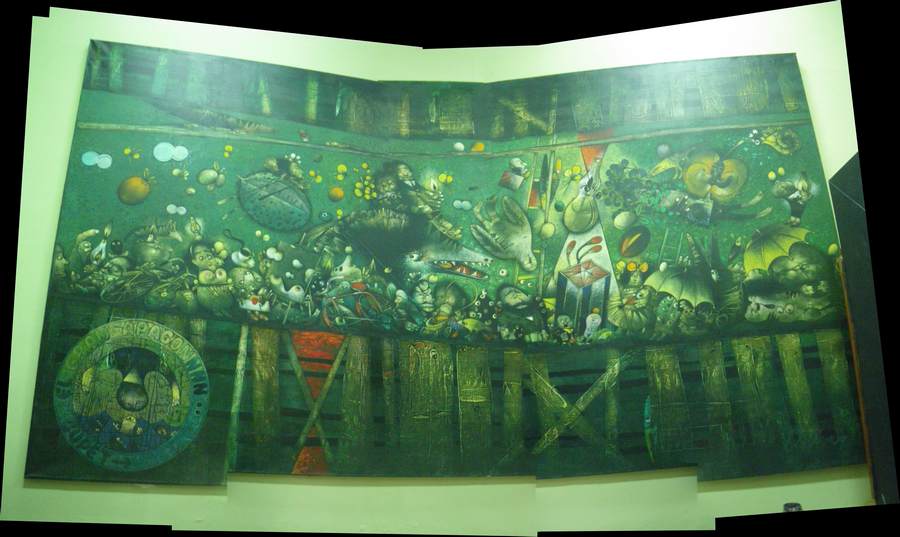
We went up to the street to Casa Toller, a private residence owned by an artist that gives free tours. The artist, Pedro Pablo Oliva, is an old man now and he is quite famous. A young man named David spent almost an hour talking to us most of the time on “The Great Blackout” a painting about the 1994-95 and the crisis caused by the fall of the U.S.S.R and the problems caused to Cuba and how the political leadership and the people dealt with the crisis. A lot of history in the painting and it is huge, my guess its 10ft by 30ft.
The artist grandfather actually killed Jose Marti, a national hero and legend. The spanish were afraid to kill him but the grandfather did. The artist features Jose Marti, as a way of honoring Marti, and as a way of saying that he is not like his grandfather.
We walked back to the casa and chose our room. They had two rooms available. When we were sitting in the park trying to decide what to do we were approached by a woman who was advertising the casa that we were in. Apparently if they don’t have both rooms rented they will send out people to solicit tourists.
We took the time to buy our tickets out of town when we arrived at the bus stop just to save the Vinales hastle of trying to buy the ticket the morning. It took a while but happy that it was done. Our Casa (top choice in the lonely planet guide) is only a couple blocks from the Bus Station. Across the street is the La Mia, a grocery store, hardware store, a general supply shop. Water and beer is cheaper here than at our casa. We bought our water and a beer and walked across the street to the casa. I screwed up my math yet again but we should be ok. Bonnie just read an interesting statistic, Cuba has a car ownership rate of 28/1000 the US has a rate of 850/1000.

We went back to the cigar store and bought another pack of cigars for other smoker friends. The cost of each of our cigars works out to be about between the cost of our so-so bottle of rum and the good bottle of rum we bought. The La Occidental Guayabita del Pinar is made here in Pinar del Rio. We went to the distillery. The berry, according to the web a dwarf guava, is added to vats of about 1/3 alcohol then put in barrels for 3 months, then bottled. There are two kinds a dry 40% alcohol, and a sweet 30%. We actually like the 30% better than the 40% which is unusual for us, we usually like the dry much better.
From there we walked around and got lost, we ended up on the wrong side of the tracks. Our map ended at the railway station and we were going off of our map. We returned to our casa and dropped off our souvenirs. Then down to the bus station to ensure that we knew where it was after we got so disoriented. We found it no problem just two blocks away. Bonnie wanted to get and ice cream. There is a national chain of ice cream stands. So we got in line, there always seems to be a lineup at the ice cream restaurants. There was a long line that took about a half hour for us to work our way through. Three was a group of six of us that were called in together, a couple of elderly women that sat at a table beside us and a teenage couple that joined us at the table. They had no english and with our little spanish we didn’t get to converse much. We ordered two dishes, a chocolate, and a Monte Carlo. We weren’t sure what was but that was the choice. The Monte Carlo turned out to be a sweet vanilla. Two scoops of ice cream in a sunday glass, with two biscuits with a little sauce. Bonnie and I switched as usual which caused the teenagers to giggle a bit.
When we got our bill it came to 2.10 so I gave the waitress a 5 CUC. She just shook her head “National Pesos!” The waitress just shooed us away like she wasn’t going to bother but the teenager said they would pay our bill. We wanted to pay our own bill but the waitress disappeared before we could dig out our change. For some reason, both bonnie and I were having a math issue, our math skills seemed to completely disappear, they seem to have been on the fritz all trip. The teenage boy put three coins on our bill to say that it was paid. I gave him 0.50 CUC to cover the cost and hoped that it was enough. When we got home and were less flustered we figured out that our 2 Sundays of two scoups of ice cream each came to about 8 cents. When was the last time you waited in a half hour line to get 8 cents of ice cream. The 0.5 cuc was probably enough to pay for their ice cream and ours as well.
One thing that I noticed was that the waitress poured everyone a glass of water but no-one touched a drop.
We came back to the casa and had a shower and to give us time to pack. We bought another 1.5L of water at La Mia and I settled in to write the great ice cream saga, and read a little.
Next time it would be worth exchanging 4-5 CUC to National Pecos just to have NP for street venders.
February 22 2013
We stayed at:
Casa Mercedes (Havana)
Address:
Street O’Reilly #506, Villegas & Monserrate, Old Havana
Phone(s):+53 7 8634493
Email:
jormer506 AT hotmail DOT com
Cost(s):
$30 CUC per night
$4 CUC per person for breakfasts
$10 CUC per person for dinner
Bus service: Havana to Varadero $6
We were the only couple at the casa both nights and the food was good, especially the baked chicken.
We got the bus to Havana and arrived at Casa Mercedes. Of the two casas in Havana we liked 457 Concordia better. But Casa Mercedes is a much better location for touring Old Havana. Breakfasts are better and cheaper at 457.
We arrived in plenty of time to walk around Old Havana. We are constantly surprised at how small things really are here. Even at a stroll it doesn’t take us long to walk from our casa, not far from the Capitolo to Places des Armes, a stones throw from the harbour. Our casa has a safe which is nice, we don’t have to worry about carrying a lot of cash and our passports.
We walked around and found a number of art galleries to explore. One woman we met in one of the galleries was a Canadian who spends a lot of time in Havana said that the streets here are fine during the day but at night you have to be careful, yeah that’s true everywhere. She did tell us that we should go to the Canadian Embassy for their Friday night “Polar Bar” for the free beer. Long way to go for a beer. As we walked around we disturbed a few peacocks and their hens. They are pretty birds.
We walked down to Places des Armes as a walk before dinner and there was a stage set up in front of the main building in the square. People seemed to be milling around waiting for a show to start, so we waited too. Sure enough there was a cultural show being put on by Mexico as part of the Festival. Music, dancing, and colorful costumes. Took quite a few movies and wasted a lot of disk space.
We had dinner at El Coco, we had two good meals with mojitos for $13 CUC including the tip. The service was good and the food was good too. Casa Mercedes wanted $10 CUC each and that’s expensive with so many restaurants around.
We had met the greeter earlier in the day. A cute blond with reasonably good english that seemed interested in talking a bit. We weren’t interested in eating at the time but she was still polite and willing to chat a bit. The fact her english was good was something that could make our life easier, the prices were reasonable, and the place looked clean, so we said we would be back. When we came back we sat near the window, both for the street theater, as well as the breeze. The blond waitress was quick to shoo away anyone who wanted to bother us and she attracted a number of other customers as well. One of them asked where she was from. We see a lot of Cuban people but not a lot of blondes. She smiled and said Cuba. Cuba’s demographics are interesting. It is 65% white, 25 % mixed, and 10% black. There are 11.47 million people, 17% over 60, life expectancy of 77.6 years, and a literacy rate of 99.8%
February 23, 2013
We took a ferry trip to the fort on the opposite side of the harbour from Havana. There is airport style security at the ferry terminal. In 2003 there was an attempt to hijack the ferry by people disguised as tourists, since then security has been a bit tighter.
We arrived at the ferry terminal in Casablanca and walked up the hill toward the “Christo de la Habana” a 60 foot tall statue of Christ in white marble that looms over Havana. The statue was commissioned by Batista’s wife. She had made a vow to finance the statue if her husband survived the attack by students at the Presidential Palace in 1957. It was commissioned in 1958 and finished a week before the Revolution, now that’s timing for you.
Across the street from the statue is a museum on “Che”. He is revered here, much more than any other leader of the revolution.

From the base of the statue we took a number of pictures of the harbour to be stitched into a panorama. There were 13 ships in Havana harbour, loading and unloading, container ships, oil tankers, and bulk carriers.
From there we walked around to the fort, in front of the fort is a presentation of a lot of U.S.S.R military hardware, a MIG fighter, anti-aircraft guns, surface to air missiles, and a couple of serious looking missiles, one looked a lot like one of the SS-4 medium-range ballistic missile that caused the October crisis. A short “history” of the Cuban Missile from Castro’s point of view. It was interesting to see a photo the U2 plane took of Los Palacios showing the missiles. We drove by Los Palacios on our way to and from Pinar del Rio.
We arrived at the fort and the 22nd annual international book fair was in full swing. Which meant we were able to get to tour the fort for $1CUC I think if we had 3NP we would have got in for that.
Practically every Spanish speaking country was there and had lineups full of teenagers! Lots of book and the other fort was full of craft show and exhibitors. Lots of stuff, from Dollarstore kitch to really nice stuff. I was thinking seriously about a carved leather backpack for $25CUC but untreated natural leather really doesn’t do well in a marine environment. Lots of really nice stuff, there was lots of stuffed priced in CUC for local consumption, that’s an interesting trend.
We walked between the forts and saw a small little cove off to the side of Havana Harbour. There were people swimming in the little cove but looking at the water I would not suggest that. It was a pretty cove, one that we would probably sneak into if we had a chance with our boat. I doubt that the authorities would allow that, but if it was in the Bahamas, it would be a lovely little place to hide from a front.
We walked around the fort but were not able to get to the lighthouse, it was off limits during the festival. We did explore around as much as we could it would be an interesting fort to explore. We got to an overlook that showed the mouth of the harbour. It was a falling tide and the water coming out of Havana harbour looked pretty brown. Not a great place to swim.
We went to the Europa, they have a band that works off of tips. There were so few people there that they even gave up and took a break. There were two male waiters and one female. We got one of the male waiters. We could not remember having worse service anywhere. Bonnie was ticked “OK tired of being ignored now!” We ordered the special which was supposed to include a mojito, an appetizer, a main course, and a desert. We ordered a side order of plaintain and the female waitress came over to tell us that it wasn’t available. The final straw was when we asked for the check (in spanish!) the waiter stuck up his hand and said “Mojito!”, we both screamed “No!” and said “the check!” one in english and one in spanish! He nodded his head and went over to the table where the napkins and cutlery were and grabbed a bunch of stuff and started to reset three or four tables. We finally just got up and went to the bar to pay the bill. Which still contained the plantain, and a 10% service, both those were taken off the bill and we left, vowing never to return.
We walked back to our casa just one street up from Obispo the main walking street for the tourists. We walked up Villegas, at the corner of O’Reilly, we noticed that the art gallery that we explored earlier in the day was now a dance studio. Three or four couples were in there dancing. Bonnie is always amazed at how the Havana ladies can walk on cobblestones with 4 inch heels. We watched the dancers for a few minutes and made me wish I didn’t have two left feet.
The murals on the walls on the corner of Obispo and Villegas are people that live around there, the man with the long beard and coat is a mime that we have seen perform. We have enjoyed spending enough time in one area to get flavor of it.
February 24, 2013
It was a Sunday a chance to see all those churches that are closed the rest of the week. We went hunting churches. Any that were open we slipped in the back and took photos if we could. We went to the cathedral up by the Grand Lodge. Incredible church but with a service in progress we really couldn’t wander around like we wanted. So we just took a few pics from the entry and left. There are a lot of churches in Havana. We saw a lot of Catholic churches, a Baptist church, a Russian Orthodox church, even a Synagogue.
We stopped and went into a grocery store aimed at the locals, things were priced in national pesos. The grocery store was what we would call a dry goods store. A box of rice was a little over a peso, a pound of sugar about the same.
On our way searching Havana for churches, we walked through the Havana market. There was all kinds of fresh produce, lots of flowers for sale. There was a big truck that looked like a dump truck except the box seemed to be solid. On top of the box above the cab of the truck was a pile of carrots, 2 to 3 feet high across the whole top of the truck.
We dared the Prado again, on Sundays the artists that are there are teaching people to do crafts. As we walked we watched drawing classes, macrame classes, a woman teaching how to make bobbin lace, water color painting, oil painting, and pencil sketches. They were interesting to watch.
There is a building used for weddings on the Prado, there were two weddings queued up, we stopped and watched a bride come out, get into the car and head off.
We walked our way back toward our casa and on the way we noticed that in the middle of an intersection there was a car with the front wheel completely off the car. It looked like they were replacing a tie rod. They fix the cars where they fall here. No fancy garage or tow truck, the car was jacked up and a few guys started to work. Traffic just worked it’s way around the car and they worked away.
We walked down to Plaza de Armas to see if there was another show and on the way we ran into another group of street performers, stilt walker’s this time. They picked up kids and walked with them, the bowed down and walked hand in hand with little ones, they danced they played music and then lead the crowd to the Placed des Armes and there was going to be a show that evening. It was an arab country, not sure which one. They invited a few people to join them and it took a few minutes for us to realize that they were the stilt walkers that had changed out of costume and returned to watch them.
We walked back along Obispo and went to the Basque Bologna they have a band during the day and we were kind of expecting another band to show up while we were eating dinner, so we chose a table a little farther from the stage. It was a slow night but we eat early so that might have been the issue, but there were four or five other tables and people came in after us. We ordered two drinks, one special to share (dinner a drink and dessert). We noticed the bartender disappeared out the front of the restaurant and returned with a bottle of rum, then our mojitos appeared, the cook disappeared out the front of the restaurant and returned with rice, and then disappeared again for something else. It almost looked like they were shopping for the meal as they were cooking them.
The main course we had was good and the service to that point had been very good, then the girls showed up. A couple of very pretty friends of the waiter and bartender showed up and sat at a table on the other side of the restaurant and that was the end of the night. The German couple behind us were livid, at one point Bonnie watched the German woman get up and go to the kitchen returning her food, it was so bad. The couple in front of us ordered the same thing we did and gave up waiting for the dessert. We had to ask for ours explicitly. What was going well for the first half hour turned into an hour and a half of frustration. Bonnie and the German woman may speak different languages but the body language was the same, livid! At one point Bonnie and the German woman were just looking at each other with exasperation. The second night of being ignored was not sitting any better than the first night.
We left and went back to casa with another restaurant checked off of the list.
February 25, 2013
We set our sights on the Museum of the Revolution as a start for the day. It was formerly the Presidential Palace. The first thing you see on entering is a beautiful white marble staircase. It was here that Batista came under fire by the students in 1957, he escaped them by fleeing to the upper floors. Which brought on the vow of his wife to build the statue of Christ. The Palace is a beautiful place to see. The hall of mirrors, was the reception hall for the Palace has huge mirror’s and a beautiful ceiling frescos. It was undergoing a bit of a maintenance on one of the chandeliers while we were there. The hall itself was pretty impressive.
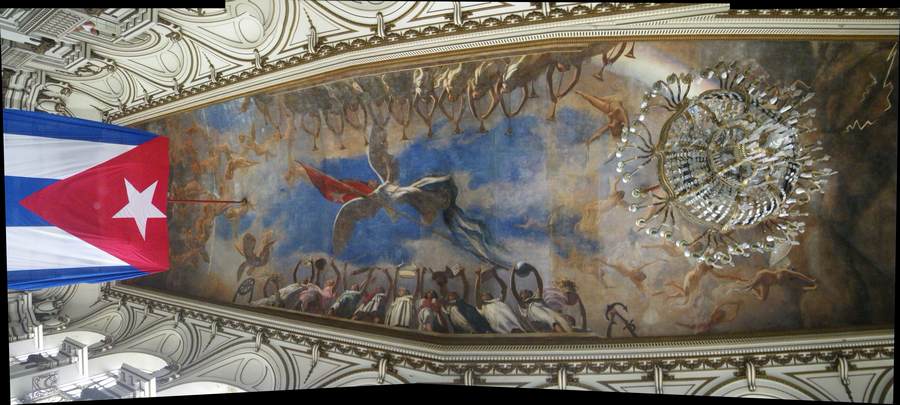
I spent several hours stitching together different images of the Hall of Mirrors at home and was never satisfied with the result, I have to admit a lot of that time was spent admiring the frescoes.
The building itself is well worth the visit. I admit that no matter what government I’m dealing with (Cuban, Canadian, or US), I have a tendency to look at the information as 99% propaganda and 1% truth. It was really easy to determine the worst of the propaganda in the museum, it had English subtitles! They only translated the really “good” stuff.
The Granma Memorial is a included as part of the Museum of the Revolution and it includes the yacht “Granma” which carried the 81 revolutionaries, including Che, Fidel, and Raul. Along with it are other military bits that have played a part in the revolution. Jeeps, a delivery truck full of bullet holes, part of the U2 shot down during the October Crisis, a surface to air missile, part of a B29 shot down during the Bay of Bigs, an old aircraft used to fight in one of the battles in the revolution, and a pic or two of the Land Rover used by Fidel for Gord. The tank that Fidel used during the Bay of Pigs to shoot one of the invading ships, the “Houston” is out front.
We walked around Havana stopping to admire the Bacardi building. Bonnie says we drink way too much rum. It is an incredible art deco building covered in different colors of granite and limestone, with motifs in terracotta. We walked over to the Plaza des Armas to see if it was set up for a performance but the booksellers had taken over that area so it doesn’t look like we are going to get any more shows. The festival is over so that ends the shows. We enjoyed the stilt walkers with their band and sat down to eat at La Mina, an open air restaurant in the Plaza. We were very happy with the food and the service, it was nice to have good service after the two nights of things going badly.
February 26, 2013
We decided that today was a good day for the art galleries. We were still recovering from a nasty cold and cough that we had picked up from running the air conditioner in our casa. Normally we would rather put up with a little heat than run an air conditioner but it was too stuffy and hot even for us. Both Bonnie and I were suffering but I seemed to be a little worse than Bonnie in the coughing department, but the cold had settled into Bonnie’s ears and sinuses and she was not a happy camper either.
The Museo de Bellas Artes is housed in two different buildings, one specializing in Cuban art and one for international art. The Cuban art museum is a more modern “block ugly” building a few blocks north of the international art is housed in the Palacio Del Centro Asturiano.
We spent most of the morning exploring the Cuban art museum, we found it a very comfortable building, if anything a little warm. The guide book had warned that it was too air conditioned but this being winter they may have the air turned off. There was a wide variety of art to be enjoyed and by the time were were done looking around it was well after lunch. We had a cuban coffee at the cafeteria before we headed down to the international art museum. It doesn’t have the best Cuban coffee we have tasted but it wasn’t bad. We have an expresso machine in our future! We are really developing a taste for Cuban coffee.
Walking from the Cuban Art Museum, to the International Art Museum takes you in front of the Bacardi building, so I got another picture from another angle.
We had walked by the Palacio Del Centro Asturiano many times since our casa is a block away. We admired it from the outside. When we went it there was a sign that gave the prices for admission, 5 CUC for this museum and 8 CUC for both. We didn’t see the 8 CUC for both sign at the other museum, we might have missed it. It was one of the few museums we have ever been in that if you took all of the art out of the museum it would still be worth the admission price. The stain glass window above the beautiful marble staircase is incredible.
They list a number of artists in the guide books, some of which I recognized, Bonnie recognized more than I did. They have art and artifacts grouped in sections, the middle ages, US, France, Italy, German, Flemish, Great Britain, Spain, Egypt, and Latin America. With a section of artifacts from Greek, Roman, Egyptian works, including a sarcophagus, Mesopotamian, Phoenician and Etruscan finds. We even recognized works from the Hudson River School. In one gallery Bonnie was backing up to look at painting and I told her to be careful she was about to be kicked by a ballerina. There was a sculpture of a ballerina behind her, a Degas. And yes she could have really backed into it.
I was really impressed at the works of art in the museum, so there is two reasons to go to the museum, one for the building, the other for the works of art in the museum. Plan the better part of a day for browsing around.
By the time we came out, it was almost time to eat. After almost a month in Cuba we went looking for something different and something with a little more spice than we had been getting. After a couple experiences of less than acceptable service on Obispo. We were in the searching our guide for something different. There was an niddle eastern restaurant called Al Medina not far away.
Just a half a block from Obispo off the Plaza de Armas, but a world away. We really appreciated the appetizer plate with humus, falafel, and other tasty treats. The food was very good and the service was excellent. The table in the court yard just under the archway seemed to just have a nice breezeway effect that refreshed us after a warm and stuffy day in Havana.
We liked it so much that we returned a couple days later for more tasty food. None of the food we had was particularly hot, in terms of spice, the food was spiced for flavor rather than heat.
We had very good food, with excellent service at a very reasonable price.
Back at the Casa we talked to a guy who had been biking around Cuba. He gave is bike away rather than ship it back. He told us stories of his trip and he was going home early after 5 weeks. He wanted to leave while he still wanted to come back to Cuba rather than leave after 8 weeks hating it. Cuba isn’t as nice a place to go on a bike as the guide books were telling him. The roads have been “improved” with curbs and gutters to handle more traffic and the bikes are starting to get squeezed out. The buses don’t give them a lot of space to get off the road and with the curbs they have no where to go. He was from Vancouver Island.
He told us about the fort near the end of Plaza de Armas. He was stunned by the ship models, particularly the Trinidad. It sounded really interesting and that seemed like a place to go for tomorrow.
February 27, 2013
We arrived at the Castillo de la Real Fuerza, it houses a naval museum now, and the fort is full of model ships, the odd bit of gold and silver from ship wrecks and other artifacts. The Santisima Trinidad is a huge ship model. The model itself is a 1:25 scale and given that the ship was one of the largest ships at that battle of Trafalgar that’s saying something. Wikipedia has it listed as 201 ft long, 53 ft beam, and a draft of 26.3 ft with 140 guns and a complement of 1050 sailors. The model itself is over 8 ft long.
One side of the ship is “cut away” to show the interior. The other side shows the armament and examples of bringing goods on board as well as officers arriving by tender. The “cut away” side shows activities below decks. There is an excellent multimedia presentation that accompanies the ship. A touch screen allows you to select a deck to explore and as the presentation shows on the screen that part of the deck of the ship is illuminated. It is a very impressive exhibit. Norman Raine, a great friend of ours is into ship modeling and he would just love it. Unfortunately almost none of the pictures of the ship came out. If I used a flash all I got was a flash on the glass, if I didn’t use a flash, the pictures were blury, sigh.
The model is a project of the Office of the Historian of the city with international support and assistance by the Friends of Santisima Trinidad. The list a lot of people and most of them come from Midland Ontario, Canada. It looked like the Midland ship modelers guild took the Trinidad on as a project. Other credits include Canadian Tire, Buy-Rite Truck Parts, and a lot of people from around Ontario and a few from other parts of the world, including someone from Man-o-War Cay in the Bahamas. The official web site is http://www.friendsofsantisimatrinidad.org/index.htm
Other displays included Astrolabes, sextants, and other navigational instruments recovered from shipwrecks. A very old crossbow, suits of armor, as well as a bit of gold and silver. There are lots of displays of how to build a ship, done by the ship modelers. Norman would love it.
There are lots of ships models of all different kinds of ships. Lots of ships of the square rigger variety, including the Nina, Pinta, and the Santa Maria. There are also freighters, and more modern sailboats, including the Bluenose.
There is a moat around the fort and if you look down into the fort, the water has a green color that is less than appealing for a swim. Looking down from the walkway there is an “island” in the shallow moat that has the shells of huge old turtles. I’m not into turtles enough that I could identify them from above and it was impossible to tell how old they are. They could be hundreds of years old, I hoped so.
After we left the museum we went searching for a craft mall that Bonnie wanted to find. It was called La Casona Centro de Arte. We walked around until we found it. We were both still suffering from our colds and Bonnie’s cold had settled into her ear. Not only did we find a couple of nice sawdust paintings, we found a Pharmacy! It had a nasal decongestant. The “mall” has a central courtyard that had a band playing as well as a tobacco shop, restaurant, pharmacy, as well as the art shops of various artists, including pottery shops, oil and water color paintings, cooperative shops that had a bit of everything from a number of artists.
We were happy to see that El Coco was open again tonight. We were looking for a good meal and the roast chicken we had before was pretty good. It looked like the staff was completely different and the waiter’s english wasn’t as good as our pretty blonde the first night, so we had to suffer through with our Spanish, we are getting more comfortable using our limited Spanish. We had a great meal and walked back to our casa.
Bonnie was feeling crappy enough that she even took one of the decongestants, and she suffers taking a pill, she just has to fight to swallow it, but she did feel better the next day.
February 28, 2013
The Fredericton Yacht Club got an invitation from the Hemingway Yacht Club a couple months prior to our trip. The club thought it might have been some kind of scam but Bonnie and I had heard of the Marina and friends had stayed in there a couple of years ago. I was interested in going to the marina. There was another cold front passing the area which meant wind and lots of rain! We took the Hop-on hop-off bus to the end of the run ($5CUC each) and then took a taxi from the end of the run the remaining 4km to the marina. ($4 CUC) I didn’t get a chance to tell the person that had sent us the letter, but the person at the bar recognized the name and told us that he wasn’t going to be in until later there was a big reception that night, they were trying to get Havana to be one of the stops on the 2020 Volvo Around the World sailboat race.
We looked around and there were a couple Canadian boats and a few from the US. Things looked quiet It was a well protected canal and there were houses protecting the canal so unless the wind was coming right down the canal there was little chance for damage, except that there didn’t seem to be a lot of space to move. There seems to be a bit of debris between the vertical wall and where you would tie up your boat. So if you plan on going to the marina, be careful where you land. We came back dodging the showers.
I took lots of pictures of houses on the way back home on the bus, as well as a bunch as we drove around the cemetery. Bonnie thinks that we have actually managed to take a bus all of the way around the cemetery now. We also got a couple of good pictures of the University of Havana.
The surf was pounding hard on the Malecon and it was very pretty.
There was a huge yacht in the Havana harbour, The Panorama, a Greek charter yacht, with it’s own web site.
We spent the rest of the afternoon walking around Old Havana dodging showers. We ran into a group that were obviously from the US. We asked one where she was from, and she whispered “the US”, we giggle, “We know that!Where in the US?” It turned out she was from Seattle. It was surprisingly obvious they were from the US. We had seen more people from the US than we were expecting. They were with a tour group doing educational tours, “The Road Scholars”.
We were able to get into the Catedral de San Cristobal and look around a little bit.
Rather than look for a new place to eat and have our last meal in Havana be a disappointment we went back to La Medina, the middle eastern restaurant and had a good meal with a little more spice than the typical Cuban faire.
We asked our casa to arrange for a pickup to go to the Viazul Bus Station.
March 1, 2013
We stayed at:
Casa Particular Elisa and Pepe (Varadero)
Address:
Street 24 st.,
Nodarse Building,
3rd floor, Stair 306, Apartament #6
3rd Ave. & 4th Ave.,Varadero
Phone(s): +53 45 612632
Mobile +53 52648770
Cost(s):
$30 CUC per night
$4 CUC per person for breakfasts
$5 CUC per person for dinner (varies depending on what is ordered)
We were up at our regular time and took the taxi to our bus. The bus was running on time as usual. The cold front coming through gave us a view of some spectacular surf pounding on the northern shore of Cuba. We tried to take lots of pictures from the bus but the light wasn’t as good as our trip the other way and as a result the pictures were blurry.
As you travel from Havana to Varadero you pass a variety of landscapes. The quiet resorts of East Playa, beautiful valleys full of agriculture, rundown shacks, oil fields, gas fields, a power plant, a few rivers, and the city of Matansas.
We were back at Casa Elisa and Pepe’s and in familiar company. We walked with our luggage from the Viazul bus station to the Casa. There wasn’t a lot of rain but the wind was strong and the cold wind was blowing.

March 2, 2013
The rain was coming and going. We decided to jump on the hop-on, hop-off bus and take a run out to the cave. It was raining off and on so we stay below and went around the loop. We missed the drop off so we had to go around the whole end of the resort area. When we got back we had to wait for the guy to come back from doing a tour. The cave itself was not a great cave, it reminded me of the Canon ball Grotto near Staniel Cay in the Bahamas. The roof of the cave is not very thick and there are places where it has already collapsed. There are tree roots that have grown down the hole and are now supporting the tree from the floor of the cave. We did the tour which showed us some of the aboriginal cave paintings, the cave decorations, and the fruit bats. They don’t have the same problem with the white nose fungus that is causing devastation in the bat population in much of northern North America. The bats don’t hibernate so the problem doesn’t seem to be an issue. The bats are mostly fruit bats.
We looked around for a while and one of the “rooms” was full of holes in the ceiling with notable deposits of bat sign. The bats seemed to get nervous about having people around. At one point the bats decided to move, en-mass. It looked like a black cylinder of fluid falling from the ceiling about the same diameter as a five gallon pail, the “fluid” never touched the floor it just spread out and disappeared into the darkness. It was impressive! The bats poured out of the ceiling for what felt like 15 seconds or more. There were a lot of bats.
I stayed and watched the bats for a long time. At one point the guide came back with another tour and saw Bonnie watching me watch the bats. “He’s watching the bats?” he was dumbfounded. Bonnie just shrugged, “He’s like that.”
 We went to the Plaza de America, the American style shopping mall in the resort area for lunch and to hide from the cold wind and rain. The prices here are MUCH more expensive than the same stuff in Varadero itself. We looked around and watched the surf until the rain died down and then headed back toward the bus. Bonnie and I got a kick out of the huge phallic sculpture at the entrance of the Plaza de America.
We went to the Plaza de America, the American style shopping mall in the resort area for lunch and to hide from the cold wind and rain. The prices here are MUCH more expensive than the same stuff in Varadero itself. We looked around and watched the surf until the rain died down and then headed back toward the bus. Bonnie and I got a kick out of the huge phallic sculpture at the entrance of the Plaza de America.
We stopped back in town and stopped at the main shopping area in Varadero and found a really good painting. It was $200 CUC and we were seriously thinking about it. We stopped at the Havana Club tasting shop and it was so busy we didn’t bother staying for a taste. The prices were about the same as what we paid. There were lots of little shops carrying everything from kitsch to really nice artwork.
We walked the beach and had a good time watching the surf. There were lots of Portuguese Man-o-War jelly fish coming ashore. We were watching our feet pretty carefully as we were in our sandals.
We got some beautiful pictures of the black sky and the surf.
We were walking up First Ave from the shopping area and looking up the street we could see a wall of rain coming down the street. We stepped into a covered restaurant called El Caney. It was a nice place to sit and watch the rain, the food was not remarkable and neither was the service. We started back to the casa between the rain clouds and but only made it part way. A horse taxi stopped and offered to take us to our casa for whatever we were interested in paying. We had 3 cuc in our pocket in change and a $10 cuc bill, so he got the 3 cuc.
March 3, 2013
It was still blowing and it was cool but the black skies were gone and we had puffy white clouds for our last day of exploring around Cuba. We were thinking hard about going on the Matanzas Hop-on Hop-off bus. But we decided that we should have an easy day as our last day in Cuba. We decide to see if we could find the Canadian Consulate.
We were still thinking hard about the painting. It was one of the better ones of the Vinales valley that we had seen since we had left the valley. We were running low on cash and thought we would see if we could find a money exchange and get a little bit. We searched and under the ice cream shop, in the warren of little shops in the mall we finally found it. I was surprised to see that many shops that you go down to shop in. One good storm surge and the whole thing would be history. The Cadeca money exchange was in the back in a little shop, we got in line and when I took out my credit card and passport the guard looked at me and shook his head, “Only cash, there’s an ATM at the bank on First ave.”
We went and found the ATM but there was a lineup so we didn’t bother, we had enough cash to get us through. Although we were tight, and since we decided against the painting, we really didn’t need the cash. We had the money tucked away to pay the $25CUC per person airport tax so we didn’t really need to get cash.
We went to Lai-Lai for dinner, a very good Chinese restaurant on First Ave and had a spicy chicken dish. It was a nice change to have something a little spicy. The service was excellent and the prices were good. We had one dish between us with a plate of white rice and we were happy.
We would eat at Lai Lai again without hesitation. Lots of good looking food on the menu.

March 4, 2013
Flight Home
Westjet
Depart Varadero 2:25 PM Flight 2613 arrive Toronto 5:53PM
Depart Toronto 9:00 PM Flight 480 Arrive Moncton 11:55 PM
We had a reservation for the Viazul bus to the Airport. We got there early and had to wait a while for the bus. But after a month in Cuba and although our colds were gone, we were still tired from fighting our colds, we were happy to just sit and relax. We were leaving the Station at 11 and were getting to the airport about noon, and our flight was after 2 p.m. We had lots of time to get our seats, pay the airport tax, and go through security. The airport has lots of shopping for everything from Viagra to Rum, from paintings to nick knacks. The rum was about the same price as we bought it for, and the cigars were much more expensive. The price of a cup of coffee was the most we had paid in Cuba at $2.50 cuc.
The last time we had to check luggage was a long time ago, and I had forgotten what a pain in the butt it was. We had two bottles of rum with us that was about 30% of the price we pay for it at home. So we probably saved about $50 – $60 in the cost of buying the two bottles at home. Was it worth it? Maybe.
Our flight was about 40 minutes late leaving Toronto which meant that we didn’t get into Moncton until after midnight.
We arrived in the snow, a light snow but a snow. Brent and Angela had dropped the car and we managed to find it without too many problems. We were on the road with only $48 in parking fees. We were in off again, on again snow the whole way back. We were able to maintain highway speeds except for a small stretch near Salisbury where we were down to less than 50km/hr due to visibility.
We arrived home safe and sound to a clear driveway thanks to our neighbor Paul, at about 3 am and we crashed.
Feb 4 2013 – March 5 2013
February 4, 2013
We were saving several hundred dollars by traveling through Moncton Airport rather than Fredericton but that also meant that we had to drive to Moncton, spend a night in a hotel, and do something with our car for the month we were away. Even with the additional expenses of using Moncton it still worked out cheaper than flying out of Fredericton.
We were fortunate to have a couple of nephews in Moncton to call on. Bonnie’s nephew Brent and his wife Angela lives near Moncton and have space for our car. Unfortunately she took a bad fall on a patch of ice and wasn’t able to drive, and Brent was away. So we called on my nephew Craig to get us from Brent and Angela’s to the Super 8 near the Moncton airport. Brent and Angela promised to drop the car at the airport long term parking lot as close as was convenient to our return date and we would drive home from there. We were scheduled to arrive at 2355 on March 4 so it was too late to do anything but grab a room if the weather was bad, or drive home if the weather was good. We hear rumors that Westjet is considering bringing in a regional carrier to Fredericton, and if this is true, maybe prices will drop flying out of Fredericton so that the additional hassle of flying out of Moncton is not necessary. Even after all of the additional expenses of flying out of Moncton we figured we are up at least $200 on the price of tickets from Fredericton.
February 5, 2013
| Flights to Varadero Westjet Depart Moncton Depart Moncton 6:00 AM Flight 659 Arrive Toronto 7:25AM We stayed at: Casa Particular Elisa and Pepe (Varadero) Address: Street 24 st., Cost(s): $30 CUC per night |
We were leaving at 6:00 a.m. so we had to be at the airport even earlier, but we had our boarding passes and were just traveling with carry-on luggage so that made our lives easier. We got there at 0430 and that was fine. I think I would have been more stressed if we had to get our boarding pass, the lineups were long when we got there. Having the boarding passes in hand and with just carry-on luggage we walked straight to security and our gate.
We had an easy flight, 2.5 hours to Toronto and then another 3.5 hour flight to Varadero. We had lots of time between flights in Toronto so the walk between gates was not an issue. Both were Westjet flights but we seemed to walk a good length of Terminal 3 to get from one to the other. We had enough time that I was able to go to the Tim Horton’s and get breakfast before our flight to Varadero.
When we got into Varadero the first thing we did was change cash over to the Convertible Pesos used by tourists in Cuba. We exchanged $1000 Canadian and the exchange cost us about three percent. From there were got a taxi to our casa. I think we paid a little too much, but what the heck. I was expecting to see the money exchange inside the airport arrival area but it is actually outside on the right from the arrivals door. If we were smart we would have teamed up with someone in the money changing line and split the taxi to Varadero.
One of the things that I did before we left was write out a detailed itinerary with much more info than I normally had. I had included normal things like detailed info about the dates and the casas with street addresses and phone numbers, but also included the Viazul bus schedule with all of the times between the place we were at and the place we were going. It had a map of where the casa was and where the bus station was. The idea being that if we ran into someone who had no English at all we could probably make our way by pointing at the dates and addresses or the bus schedule and with lots of waving and our VERY limited Spanish we would survive. We used that detailed itinerary a lot. Some of the Viazul bus station ticket agents had a little English, most didn’t have a lot. But with patience and pointing and a very little Spanish, we never had a problem getting what we needed. The taxi drivers were able to keep the itinerary in the front seat with them and refer to it as they traveled. Some of the taxi drivers had pretty limited English as well. They were able to read my notes about where we were going easily. Literacy rates are higher in Cuba than either Canada or the U.S.A., so I knew that the more I could give them in written form the better off we would be. Street addresses are street addresses in English or Spanish, phone numbers are phone numbers. The maps were less useful to the taxi drivers than the addresses but they were very helpful to us when we were walking around. We would get to the point where we knew we were within a couple blocks of the casa and we could dig out the map and find it.
We arrived at our first casa on our first trip to Cuba and had a bad stomach moment when we saw it. It didn’t look good. We walked up what we thought were the right stairs, they were dark, dusty, and very narrow, up three flights and I was getting more nervous with every flight. The stairs were marble and with the dust, were a little slippery. There was no light other than the sunlight reflected on the bottom steps. We knocked on the door and Elisa was there, we had arrived at the wrong door. The door to Elisa and Pepe’s apartment, not the casa entrance. But Elisa was very friendly and her English wasn’t great but we were able to communicate what we needed. Her English is much better than our Spanish. Her son Joan, studying civil engineering at the University of Matanzas does a lot of his school work in English and was able to fill in any blanks for us. Joan was interesting to talk to and we enjoyed his company. Elisa was a lawyer and now has the casa and raises her son Joan and her daughter Julien, in grade 10 in the pre-university program. Julien seemed a bit shy, we only saw her twice and that was only for a second or two.
Our room was spotless, clean simply does not describe it well enough. Everything looks new and the tiles on the floor don’t appear to even have a scratch on them. I felt guilty for wearing shoes in the room and took them off as soon as I could. The Super 8 in Moncton wasn’t in the same league as Casa de Elisa y Pepe.
Bonnie and I are what I call lazy travelers. We don’t try to fill every minute of every day of our trip to the max. When we have a travel day, that’s all that we plan on doing that day. So we when we arrived at a casa, we paid for all of our nights, all of our breakfasts and usually dinner for the two of us for the day that we arrived. We didn’t have to, the casa owners seemed to be fine doing it a day at a time, but I was happy to have our bill paid and be settled.
When Elisa filled out the paperwork she found out it was Bonnie’s birthday the day before.
Dinner that night was very good, we enjoyed it and went to bed early. We were tired after our day of travel. We normally slip easily into “boat-mode” when we are traveling which for us means up with the sun and down with the sun. When we are close to the equator that means we get a very good night sleep. Daylight lasts more or less 12 hours at the equator. I think Elisa and Pepe found it amusing that we crashed so early.

February 6, 2013
While we were waiting for our breakfast we watched the elementary kids being delivered to the school just down the street from the casa. The school uniforms were red on the bottom and white tops. School opens early for the parents to get to work, I think the first kids start arriving at 7.
The breakfast was special, Bonnie had a cake with a candle! I had a piece of cake. The breakfast consisted of lots of bread, lots of fruit, juice, coffee, fried eggs (although we did switch over to having boiled eggs when the amount of oil we were consuming started to disagree with us).
Our first task for the day was to find the Viazul bus station. Viazul is the tourist bus service that runs like clockwork all around the island, with modern buses and reliable service. The bus station on the map above is the Viazul bus station. We used them for all of our major trips between stops, with taxis between the bus station and the casas in Havana. We walked up to 4th , the road between the military barracks and the major highway, the Autopista Sur. When that road ran out, we walked along the path until we came to a car rental agency, across the street from the car rental agency is the Viazul bus station. There was a taxi driver trying to get us to hire him for a door to door service for $60. The bus cost us $10 each plus another $10 from the bus station to the casa, so $60 was twice the cost, something that if we had another couple with us we could consider doing. We bought the tickets and got reservations, two different things and getting a ticket didn’t necessarily get you a reservation, and you could get a reservation without a ticket.
Almost directly down from the bus station on First Ave is a stop for the Varadero Hop-on Hop-off bus. Tickets are purchased on the bus at $5CUC each. We decided to do a complete circuit on the bus and then decide where we would get off. There are lots of construction cranes and development on the resort end of the sand spit that is Varadero. In Varadero there are lots of casas. We saw the little Casa symbols everywhere.
We really enjoyed being on the top of the bus where we could see the blossoms at the top of the trees up close. The trees seemed to be covered in blossoms of every color.
After the ride on the bus we went looking for the Municipal Museum. We found the Infotur office and the woman explained our map was very old. She gave us a few maps that she had to help us find our way around. She was very nice and very helpful. We did find the Municipal Museum and it had some beautiful old furniture and plaques on a number of things. Unfortunately, most of it was in Spanish. This was true for most museums, we need more Spanish! Bonnie was better at reading than I was. The Museum had a presentation of a flora and fauna including a two headed shark! It was small and I doubt it survived long in the wild (if it was real at all). 
We walked out on the upper veranda of the Museum and admired the beautiful view, while watching carefully where we were stepping. It had that feeling that if you got too far off the mark you might go through! The view off of the veranda was incredible.



From the Museum we went to the little restaurant on the beach next door. The “Lifeguard” was the waiter for the patrons on the beach. He was tending the two ladies with considerable interest. It was a beautiful day and the scenery from the deck was a fantastic series of blue from the beach to the sky.
We walked down the beach and then returned along first ave. We were wondering about getting a SIMM card for my phone but decided not to bother. If we really needed it I would get one later.
The tourists from all the resorts were in town looking at the shops and filling up the town. We stepped into Parque Josone to do a little walk and explore. It is a beautiful little park and absolutely quiet. We almost had the park to ourselves. There is a little lake in the park and across the little bridge there is a restaurant with a cave. We didn’t eat there but we heard from a friend after we got back that the restaurant in the cave had the best Mojitos she tasted during her trip to Cuba. Susan and Richard were the people that told us about the Casas and inspired this trip.
The park was a great respite from the tourist hordes across the street. There were lots of interesting blossoms in the park and cars to see on the streets.
We went to dinner at Casa Miel (honey) a restaurant. The food was very good even if the waiter was very poor. The prices were reasonable too. Some of the restaurants we saw were expensive even for prices at home. Most restaurants had main courses for 6 – 9 cuc. We had Elisa call our next casa to say that we were coming. Making the call is something that the casa owners really appreciated.
February 7, 2013
| We stayed at:
Casa Mirador de Concordia 457 Havana Address: concordia 457, belascoain y gervasio centro habana, Email: juliocea AT infomed DOT sld DOT cu Cost(s): $25 CUC per night |
We had breakfast and walked over to the bus station. It was a long walk with the bags but doable. We did a little reading and waited for the bus. There were enough people for Viazul to put on an extra bus for just the people going to the airport. We can use that for our return trip to the airport. The Havana bus stops at the airport and costs only $6 CUC each.
The Viazul bus stopped at a number of places on the way through Havana to allow people to get off close to their hotel or casa. We decided that we would go to the bus station, buy the tickets to the next place, make the reservations and take a taxi to our casa, that way we would have everything set up for the way out of town. We wouldn’t have to worry about trying to find the station and getting to the station to do it later.
We got our tickets to Vinales from the small booth directly across the station from the arrivals gate and then went down to the entrance of the bus terminal where we made the reservations. The taxi from the bus terminal to the casa at 457 Concordia was $10 CUC. We ended up with a bit of a tour of the area as the taxi got lost and had to make a couple extra passes to find the street because of construction in the area.
Leticia, the owner of the casa, said that the area was safe, but to keep the door locked. Her English is pretty good. Alejandrio, her husband has very limited English. We ordered dinner at $7 CUC at 7 pm and went out for a walk out to the Malecon and all the way down to the fort. It wasn’t nearly as far as we thought it was. The area is very run down in places, but there are little shops, restaurants and businesses everywhere! The balcony of the casa looks out on the street and we could see a guy painting a mural between the buildings. We met the owner of a restaurant and he invited us in to look around and take pictures. The guy was still working on the mural when we toured the restaurant. Many more Spanish lessons are a must. We found a number of houses with masonic symbols on the door as we walked around.

We have adopted the idea of the travel day and it seems to be working very well for us. On a travel day we don’t plan on doing anything else that day but travel. Have breakfast, go to the bus station, travel to the next bus station, buy the next set of tickets out of town, get the reservations, get a taxi to the casa, settle in, eat dinner at the casa and bed. Seems to work for us. Anything extra that we manage to get done is a pure bonus. Of course we do get a bonus every travel day, but not planning anything extra makes the day much less stressful. We were able to get to the Malecon and down to the fort then we worked our way back to the casa. The potcakes (free ranging stray dogs) are not as well fed in Havana as they are in Varadero. Many buildings are in very bad condition, a few are being restored, and are beautiful. A few cranes in Havana too. The government seems to be spending a lot on infrastructure and people seem pretty busy.
Sitting on the balcony in deck chairs you can buy at Canadian Tire, we watched the life on the streets below us. People seem very industrious, clean, and happy. Kids in elementary school have red and white school uniforms, middle school are tan pants/skirts, there are more police here, dressed better, on foot and bicycle patrols. Bonnie calls the area high density, people of all ages, babies to elderly. Lots of old American cars. All the newer cars are Geelys, Kias, and Hyundai. Ladas are old too. There are a few old Land Rovers, and a few newer ones too. Motor bikes and scooters are popular. Buses are mostly Yutang, there are lots of car logos I don’t recognize. Bonnie and I enjoy watching the life in the streets, our own street theater.
February 8, 2013
“Stay away from the Prado and the capitol!” we screamed. Our first day we hit our limit of hustlers in about an hour. “Cuban cigars cheap”, horse carriage rides, bike taxis, the list is endless. San Raphael is a pedestrian street that seems to be very much oriented to the locals. We had a couple of Mojitos at a street bar and the waiter fended off the hustlers, worth the price of the Mojitos by itself. We did a lot of browsing in the local shops and I’d be surprised if there is anything that the Cubans really want that they can’t get, including New Balance shoes made in Maine. The next time we come we will probably bring pencils and pens and skip the trinkets entirely. We walked for a few hours and then went back to the casa for an hour or so to recover from the hustlers.

They were redoing the curbs and drains in the next block when we left in the morning and most of the block was done by our afternoon rest break. There seems to be a large population of LGBT individuals in the San Raphael shopping area. We saw an number of nice galleries and good art work and we will come shopping again on our return trip back to Havana.
The buildings in Havana are incredible. The capitol building looks exactly like the capitol building in the US, the International Art Gallery, the Bacardi Building, the National Theatre, all kinds of different architecture.
We went to dinner at the Notre de Bijeux restaurant around the corner from the casa. The mural was a little farther along and it was certainly an interesting place to visit. Unfortunately the food is better at the casa and a lot cheaper. The service was good but the cook is not as good as at our casa.
After dinner we sat out on the balcony and watched the street theatre. A car stopped across the street, it was a huge old American car, and like the red car in the picture showing the view from the balcony. It was full of flowers, the passenger seat was full, the back seat was full, the trunk was full. The driver got out and took several large bunches into the house and returned with a couple other people and they came out and got more flowers. After that the car disappeared and a while later the people came out and were off for their flower deliveries.
Kids of all ages were out to play in the street. The older kids looked after the younger ones. They played “ball”, a catcher (no glove), a batter (a guy with a stick that looked a little bigger than a broomstick), and the pitcher (pitching the plastic cap off of a water or pop bottle).
February 9, 2013
There was a spire of a church that we could see when we walked to the east end of our block. Today we were going to see if we could find it. We walked up and eventually found the cathedral. It is an impressive church but unfortunately closed during the week, so we could not see inside.
They were redoing the curbs and drains in the next block when we left in the morning and most of the block was done by our afternoon rest break. There seems to be a large population of LGBT individuals in the San Raphael shopping area. We saw an number of nice galleries and good art work and we will come shopping again on our return trip back to Havana.
The buildings in Havana are incredible. The capitol building looks exactly like the capitol building in the US, the International Art Gallery, the Bacardi Building, the National Theatre, all kinds of different architecture.
We went to dinner at the Notre de Bijeux restaurant around the corner from the casa. The mural was a little farther along and it was certainly an interesting place to visit. Unfortunately the food is better at the casa and a lot cheaper. The service was good but the cook is not as good as at our Casa.
After dinner we sat out on the balcony and watched the street theatre. A car stopped across the street, it was a huge old American car, and like the red car in the picture showing the view from the balcony. It was full of flowers, the passenger seat was full, the back seat was full, the trunk was full. The driver got out and took several large bunches into the house and returned with a couple other people and they came out and got more flowers. After that the car disappeared and a while later the people came out and were off for their flower deliveries.
Kids of all ages were out to play in the street. The older kids looked after the younger ones. They played “ball”, a catcher (no glove), a batter (a guy with a stick that looked a little bigger than a broomstick), and the pitcher (pitching the plastic cap off of a water or pop bottle).
February 9, 2013
There was a spire of a church that we could see when we walked to the east end of our block. Today we were going to see if we could find it. We walked up and eventually found the cathedral. It is an impressive church but unfortunately closed during the week, so we could not see inside.
We continued down the block and crossed to the square and looked across the street and there was a tall building with a globe on the top. On top of the globe was a Masonic Compass and Square, the Grand Lodge of Cuba. I had go over for a look so Bonnie and I made our way over and there were a number of people there. I introduced myself as a mason to an old gentlemen and he didn’t know much English and pointed over to a guy that was just coming in. He turned out to be a District Deputy Grand Master for the Havana area and a 33 degree Scottish Rite. He told me there were lodge meetings the week we were going to be back in Havana and to try to make it if I could.
We walked to the Jose Marti Memorial, a large tower (the trip to the top of the tower is closed for renovations) We spent a fair amount of time walking around the base and taking pictures. We would have paid the 5 CUC to get to the top. The view would have been spectacular. Spanish really is needed to get much of anything from the Cuban museums. Bonnie and I are both interested in learning Spanish.
We walked the route in the Lonely Planet guide for central Havana to see the Avenue of the Presidents, the British Embassy and a lot of really neat architecture.
One of the things we started to enjoy was returning to the casa in the early afternoon and watch the Cuban life as the people lived. Kids coming home from school in their uniforms, red for elementary, brown or beige for middle, blue for seniors. They change and come out into the street to play. The older kids watch out for the younger ones.
Lots of street theatre. The casa owner Leticia is a better cook than the chef at the Notre de Bijeux and his meal cost double. We found a nice little restaurant one street up and toward the capitol. I forgot to write down the name. Bonnie has hit her salt tolerance and was not feeling well. We had a vegetarian pizza and a calbasa (pepperoni) pizza, I ate most of mine and Bonnie had a piece of hers but she went home and was sick. The next day I hit my grease tolerance I wasn’t good. We both recovered and but were sore the next day. We didn’t do much but walk the Malecon. We ate at the same place that night and split a meal, 4 CUC and 2 for drinks for two people and we had plenty. At this point we started changing how we ordered in restaurants. We start ordering one meal and share it, if we are still hungry we order another meal. Rarely do we ever have to order a second course. Sometimes we add a course by having a coffee and splitting a dessert.
Our room in the casa was the first room I’ve ever been in that was taller than it was in width or breadth. It was a weird optical illusion to lay down on the bed and look up. The room wasn’t as hot as I expected it to be. The center of the house was an air plenum from the bottom floors up and out to the roof at our level. The air movement with the open windows seem to keep the room reasonably cool. We did use the fan but the room got too cool and we had to turn it off.
Our only other complaint about the casa was the dog barking at night, the dog belonged to one of the other tenants of the building below us.

We did a recovery day by doing a ride on the hop-on hop-off bus. We took it on the full loop and got a chance to see the Cemetery from the bus. It is a HUGE cemetery with lots of white marble everywhere.
After our bus day, we then had a lazy day, with a horse buggy tour of old Havana. We found that the official historical guides were pretty good and made sure that English tourists got a guide that spoke good English. We met a good guide called Vincent (Buggy #29) whose English was pretty good and he offered us a tour. We were on our way to get cash so we backed away.
We did a fairly accurate calculation at what we needed for cash to get back to Havana and did a run to the Cadesca money exchange on Obispo. We stopped at another bank that was mostly populated by locals and they told us that it was not for people with CUCs. True or not we don’t know but we headed over to Obispo. I figured that with the money we had plus about a $1000 CUC we would probably have all we needed. Before we left Canada we put $1500 onto our ScotiaBank visa so that we would have the money sitting in our account when we needed to do a cash advance. Having the cash sitting there before getting the advance meant that we did not get charged any fees for taking money out. They don’t allow two at the teller at once so I went in and Bonnie waited outside. When I asked for $1000 CUC the teller’s eyes bugged out and the two tellers beside her had to come over to approve the transaction. It was a little over her limit apparently. I also asked for it in $20s, about the largest bill the locals can deal with. It would probably be better to do smaller withdrawals but it was unclear to me if we could get cash in either Vinales or Pinar del Rio. There were two banks in Vinales but it was not clear to me that either one could do a cash advance on our Visa card. I started carrying our stash in the money belt with our passports. Unlike Elisa and Pepe, this casa does not have a safe in the room.
We went to the bar next door and I slipped into the washroom to put the cash in the money belt. One of the things that is a little different than we are used to is the washroom attendants. The attendants keep the washrooms clean and provide you with toilet paper when you enter. The guide says .05 to .10 is a normal tip. We were able to gather a small amount of coins by buying water etc. Havana is not a place to drink the water, the whole of Cuba is a don’t drink the water kind of place.
We got the cash and went back to Parque Central and another historical guide “horse and buggy” wanted to take us out but his English wasn’t good so we asked about Vincent and the guided called and said he was on a tour. We waited and only a few people pestered us. Mostly older women, one hit Bonnie on the arm for saying no, Bonnie got called bad names, we might not know the words in Spanish but the body language said it all. The rudest of the pesky people are the old women.

Vincent showed us around the old town and there are lots of stuff for us to look at when we get back to old Havana. We had Leticia call our next casa and tell the owner that we were coming.
February 13, 2013
| We stayed at:
Casa de Marilyn Address: Street 1a. A #4B / A & B ,Vinales Email: casamarilyn AT correodecuba DOT cu Cost(s): $20 CUC per night |
We got Alejandrio, Leticia’s husband to take us to the Viazul bus station in the morning 6 CUC! The driver made us put our carry-on bags in the basement of the bus and I was glad all of our valuables were in Bonnie’s bag or my money belt. It was a nice trip to Vinales, the bus stopped at La Terraces in the National Park for a break. We stayed on the bus but that was a mistake we should have gone for a coffee.
We were in Vinales and met by Marilyn with a sign “Mike McDonald”, close enough. Practically every house in Vinales is a casa and there were lots of casa owners (a dozen or so at least) with signs for people another dozen or so with signs advertizing for a casa.
We settled into Marilyn’s paid for our time there and our breakfasts and had dinner with her. The food was pretty good. The guide book told us that Vinales had some of the best cooking in the country and you should eat in your casa. Marilyn mades us a “deal” that if we ate our dinners in her casa the whole time we were here she would charge us $7 CUC instead of $8 CUC. Her food was a little salty and had a lot less fat than anywhere we had eaten yet so we were happy to bite on the deal. We also asked for boiled eggs rather than fried to reduce the fat even more.
February 14, 2013
Our first day was greeted by a cold front. The rain and clouds in the hill were pretty. We talked to Marilyn about her “tours”. Her husband Adel runs a taxi and does the tour at the same rate or a little better than the buses. She also has a friend that does a walking tour as well as a friend that gives Spanish lessons.
We found the Masonic Hall on the main street just down from the bus station. “Damien @ 9am” as the sign says. Sunday at 9 am, I’m going to try.
We walked out of town in both directions and even a few places in the middle. The guide book says that there are 27000 people but I have a hard time believing it. Marilyn says there are about 7000 and the rest are in the surrounding area.
There is a lot of farming in the area as well as the free range life stock, chickens and the occasional small pig are on our street. I was awoken in the night by a rooster, in the silence of the night you could hear the roosters for a long way. I would listen and hear the one beside us crow and then when he was done the next one to the east would crow, and then the next one to the east of him, and so on and so on until you could barely hear the last one then the crowing came back from the east and the rooster beside us would crow as the wave swept to the west. Back and forth it would go a few times before it was decided it was too early and they went to sleep again. Bonnie would awake, roll over and sleep again, she is a farm girl. I’d listen to the wave and find it strangely comforting, nothing was moving in the village to disrupt the rhythm.
Apparently the men are into “stupid” cock-fighting. We have maintained our boat-mode early to bed early to rise. I think our Cuban hosts find it funny that we retire so early. Leticia had told Marilyn that we go to bed very early!
When we got home for our noon sit, there were two teams of oxen (Bonnie said they were Brahmin bulls) delivering a load of crushed rock and sand for cement. Marilyn and Adel are building another room for their casa. We have been disappointed in the birds we have seen, so far just a white egret, vultures, English sparrows, and a small green finch so far.

February 15, 2013

A three day cold front with more rain than we have ever seen in the Caribbean anywhere. In the morning we walked up the hill to try and find La Ermita, a hotel perched up high on the hill that we were told would allow us to use their facilities for a small fee if we wanted to use the pool or we could just eat at the restaurant. On our first try we missed and climbed up what turned out to be a farm road hoping for a cross road to connect to the road up to La Ermita. By the time we got high enough to find out, there wasn’t one, but the view was spectacular. We always have the best times when we get lost.
We walked to the other side of town and found the road to the La Ermita and the walk up gave us wonderful views of the valley. Definitely worth walking up to the La Emrita just for the views. We had two Cuban coffees (Marilyn’s is better!), while we were drinking the coffee the whole valley was swept by a rain cloud. We took a movie of the valley disappearing. We stay put and drank our coffee. I got to watch a few minutes of the next Harry Potter movie in spanish. The rain cleared, leaving a nice fresh smell and the sky clear of automobile smell. The walk down was very pleasant, we made it down to the casa in time to watch and wait out another shower sweep the valley. We walked down to the botanical garden and did a quick start of a look before we had to retreat to cover as another drenching rain passed over. We waited out most of it but got wet going back to the casa.
So far for dinner at Marilyn’s we had chicken drumsticks, red snapper (provided by Marilyn’s father), as well as lobster tails. We normally don’t like the lobster from the warm waters of the Caribbean, we find it rather dry. But the sauce that it was cooked in helped the dryness and it was the best we have ever had anywhere. Meals have been soup with white rice, a plate of vegetables (cucumbers, tomatoes, green beans, and sweet red peppers as a garnish), a fruit dish (bananas, mango, pineapple, and guava), fried plantain (Marilyn was surprised and pleased to find out that Bonnie especially loves the plantain), and then a meat dish. The food is very good, Marilyn was worried about repeating the dishes as we were staying for seven days but we were happy.
February 16, 2013
The weather looked better but still not good. We delayed our car tour so Adel could do cement foundation work on the new room. He had friends arranged to come over to help so the next day I think he was happy to sit while we toured. We drove around in the old 1948 Chev. No guages worked that I could see, including the speedometer. When I get into a car I tend to lean back against the seat to pull my legs in, not a good idea, gentle on the old car. I was afraid that if I did it again, Adel and I would have been laying flat in the back seat. The engine in the old car was replaced by a Mercedes-Benz diesel “two times rebuilt” for $2000 cuc. That’s a lot of money.
Adel took us to a couple of places not on the regular “Vinales tour” available from the Infotour booth as well as all of the places on the tour. We stopped at the Palenque de los Cimarrones, also called the Cueva de los Cimarrones. He asked if he could pick up at the end of the service road but I thought it would be nice to walk out. I heard that it was 800 meters, Bonnie heard 300 meters, Bonnie was closer to being right. The cave was nothing special, there were a few draperies but what was interesting every once in a while there was a seam of granite with quartz viens, the magotes are not pure limestone by any means. They had crafted and painted a number of snakes on the limestone and it was cave itself was not overly impressive. Our ankles were covered in little black biting insects when we emerged from the cave, the next day Bonnie’s ankles were covered in welts. Mine showed bites but Bonnie reacts to the bugs in the south much worse than I do. I react much more to the bugs in the north than she does.

The service road was worth the admission. It was flat so there was was no strain walking out, the views were special. We enjoyed our walk back to the car. The “slave village” tucked into the corner of the hill with the hills around it were beautiful. We enjoyed the walk back to the car by the service road much more than the walk through the cave, no bugs either.
We went to the Cueva del Indio. There is a walk through the cave that has some nice cave decorations, bacon, draperies, ribbon, stalactites and stalagmites, a bit of popcorn, but no straws that I could see. You could go so far and then there was a boat that will take you the rest of the way through the cave. There is an underground river that appears from one end of the cave, and flows out the other side. The guide says that it is about 2 to 6 meters deep. He takes you up about 500 meters and turns around. He says it goes about another kilometer but “no lights”. On the return trip, he points out a number of formations, “seahorse”, “snake”, “skull”. I took quite a few photos and the colors were better than under the florescent lights. The florescent lights may have something to do with the subdued colors. From the Cueva del Indio we went to the prehistoric wall mural. The 120-metre-long outdoor mural was painted between 1961 and 1966 that depicts prehistoric life from dinosaurs to man. Adel wasn’t sure it was worth going all the way to the mural, you could see it from the road and if you get too close you can’t see it, and they charge you! All that is there is a canteen. I got out and took a few pictures, and we turned around.
We came by the botanical garden, but we didn’t want to waste “tour time” by going in, it is a short walk from the casa and we would rather have extra time to tour it. Adel’s english is not as good as Marilyn’s but I was able to get answers to most of my questions.
We went to the tobacco farm and they had four different sizes of cigars packed on site. Bonnie couldn’t think about how we could get them home with no protective packaging. We were thinking about cutting a large water bottle in half and putting the cigars inside. Since there are no labels on the cigars we weren’t sure about the rules for exporting them either. The next time we go I might take a food saver box and use it for protection.

Adel took us to the farm a the National Park, Casa de Confianza, and the food gardens and views were incredible. Adel showed Bonnie the difference between a plantain and a banana.
The bbinnvinales.com rep was apparently here and left us a CD as a gift. Marilyn and Adel gave us a bottle of La Occidental Guayabita del Pinar (40 percent alcohol version). It is made from a “dwarf guava” berry that only exists in the Pinar del Rio area. We are planning on staying in Pinar del Rio and supposedly not exported. They said is was because we were saying more than 4, or 6 days at their casa. We were just about to head to the botanical gardens when the real front finally arrived. The rain poured from the sky, the wind clocked north and the temperature dropped like a stone, sweater and long pants! Every time Bonnie mentions the botanical gardens it rains!

We spent the afternoon in long pants and sweatshirts and the mosquitos have come in from the cold at dusk. We were outside just before our supper and it looked like it was clearing from the west. I’m hoping the winds will clock and the sky will clear for tomorrow. After three days of rain, I’m ready for sunny and warm now. Florida must be freezing and Georgetown will be hammered with this front. We are about 130 miles south of Key west.
Vinales is living the 100 mile diet or pretty close. The rice patties we saw were well within 100 miles away, and the fish and lobster we had might be 25 miles the rest are delivered by horse and cart, 10 miles maybe. Incredible agriculture and the food tastes great.
One of the things that we have been struck by since being here is the commerce on the street. Pies, pastries, cakes, and all kinds of food being delivered by people calling their wares. Everyday we see vegetable dealers, fruit dealers, and bakers walking up and down the street calling for customers, sometimes by voice, sometimes by a distinctive horn, electronic or natural. Food is plentiful and the fruit is very high quality. Some of the peppers looked a little small, but the most part the food is unspiced but very tasty. Marilyn has laid off the salt completely. The soft boiled eggs in the morning are nice and it reduces the fat load too.
February 17 2013
We had breakfast and I went to lodge. There were 34 members, master masons sat in the east with the WM, Fellowcraft in the SW and Entered Apprentices in the NE. The lodge itself was set up more like it is in the Scottish Rite, than ours. The sign of fidelity was closer to our NFLD members than what we use in our lodge. Late comers are greeted differently. There were lot of gray haired guys but the officers were mostly young, the WM was in his early 30s, the “First Vigilante” was in his 20s, and the “Second Vigilante” was in his 20s, 5 Eas, and 4 FC.
They pass two collections the alms man, a bag, and the one for the lodge, a wooden house. I put a 20 CUC into the alms mans. The Lodge is much fancier than ours. I have a few pics. The Second Vigilante takes three steps up onto the platform where he sits, the First Vigilante has five, the WM has 5 up to a platform where the Masters have seats and then up two more for WM.
The ceiling over the WM is painted to be a rising sun, the First Vigilante has the moon and the stars. It was a privilege to attend the lodge and I would love to attend another. They seemed happy to have a visitor.
After I got back I changed and we went for a walking tour with Francesco. (He was one of the guys working with Adel pouring cement two days before). We teamed up with two Argentinian couples (one was pregnant) and did the all day walking tour (10:30 to 5:30), it was a long day. I was ready to be done for the day, the pregnant lady said “Thank you GOD!” when we got to the end of the road to her casa. I wasn’t much better.

We walked into the next valley where no one was allowed to live. The valley drains through a cave and a hurricane dumped enough rain that when the cave plugged, the valley filled and all of the people and animals in the valley at the time drowned. Since then no one is allowed to live in the valley.
We had a coco-loco (chop the end off of a fresh coconut, pour in rum and honey and shake), it was not a retry for me.
The tobacco farmer rolled a cigar for us while I videoed him. The top of the tobacco plant, the crown, makes the best tobacco, the Coheba are made from the top leaves, next are the Monte Cristo, then the Romeo and Juliet, the trinidads, and the Pategas, the rest of the plant is chopped up to make cigarettes. Never buy a hard cigar, they should be soft. The ash should be 2 cm long when a proper cigar burns. The tobacco leaves are hung in the drying sheds and then fermented for 45 days to bring out the flavor.
We walked further down the valley to the cave. It is 14km long and we discovered that the difference between a good cave and a bad cave is a $5 flashlight.

I took pictures of nothing but blackness, and ended up with several nice pictures of formations right beside us.
The valley has beautiful red soil that drains pretty well. They grow mais with beans so that the bugs attack the mais and leave the beans alone. The mais get fed to the cattle. He showed us all kinds of plants, good for purgative(enema), good for infection in the eyes, good for kidney stones, … The Argentinian couples tried to translate for us when Francesco ran out of words, but Francesco did a pretty good job on his own. The tour was $15 CUC each and it was a long walk Bonnie and I were hungry and ready for bed.
February 18, 2013
We were calculating money today and I made a couple more mistakes, silly mistakes I just shouldn’t be making. Nothing serious but annoying. I didn’t do a two times the breakfasts but we made money on using Marilyn’s services (and Adel’s), dinners were cheaper than budgeted, and the Cueva de Saint Thomas was closed with no opening date known. We are still thinking about a car trip to the beach but at $40-$50 we aren’t beach people.
We did a trip to the botanical gardens and were successful on our third try. The botanical gardens have been in the same family for over 100 years and the entrance is by donation. There are lots of interesting plans. Starfruit were hanging everywhere, cocoa pods, papaya, chenille (some of the best we have ever seen) lots of beautiful plants. Bonnie recognized more of them than I did, she is the plant person. Lots of beautiful things to see. The botanical garden was a wonder to walk around. Star fruit dripping from the trees. Tulip trees in full blossom. Too many plants to list. Unfortunately there is little to no documentation on what plants were what. We knew a number of the plants from other trips to different parts of the Caribbean. We were told the garden is over a hundred years old and in the same family.
Entrance is by donation and there is no sign telling you that this is the garden you just have to believe the guide book and invite yourself in. We spent about an hour walking around the garden and enjoyed our time.
It’s worth a trip and a donation.

We walked out of town toward Pinar del Rio to about the 23.5 km marker to take a couple of pictures overlooking the valley. I wore just my tevas and my feet were sore. We stopped back a the Tobacco place for coffee. 2 CUC but they had no change. Since I only had a 10 and Bonnie had 1.50 and that wasn’t enough, it was their problem to have change. No tip for you! And it wasn’t even hot coffee.
While we were there a fresh load of Austrians(?) arrived. I was proud of myself, I was able to help translate the menu and was able to help them a little.
We went back to the casa and started working on the journal and resting my feet. We watched the street vendors come and go. Various designs on bicycles built for two, and bicycles as trucks, modified seats for youngsters to sit on the crossbar with a little seat with two boards to stabilize the seat and it even had foot rests. And stereotypes exist for a reason, The cowboy with machette, spurs, hat, and boots just walked by on his way home from the fields.
Bonnie found a good highway map. If we were driving we would get the Cuba Highway Guide by Max Cucchi ISBN # 978-84-601-7008-1
Nothing of any value seems to go to waste here if they can help it. One of the farmers came by the casa to pick up food scraps in a bucket, by the time he had visited 3-4 casas his bucket was almost full and he was off to feed his chickens/pigs/turkeys. Everyone seems to help where they can.
Marilyn’s dad was visiting and he had dropped off some vegetables and fish. She pays him for it. He lives on a pension of a 225 National Pesos a month. He worked most of his life for the government. He’s 62, Bonnie is 61, she has had a much kinder life. He has a small farm with Metza, Guava, lemons, plantains, bananas and other stuff. He also goes fishing and provides Marilyn with fresh fish.
February 19, 2013
We walked back up to La Emrita again and had cuban coffee and watched the valley change to bright sunlight. The sun is stark and harsh here. Late in the afternoon it rained again and power was off and on the rest of the night. We had lobster again, some of the best warm water lobster we have ever had. Bonnie says it is a bit too salty for her, but I liked it.
Perhaps a week was a bit too much for the Vinales Valley but we did miss out on the Saint Thomas Cavern, it never did open while we were there, and we should have done a day trip to the beach. That would have more than filled the day. We never try to do everything there is to do when we visit a place, we always like to leave something for the next time,
February 20, 2013
| We stayed at:
Casa Colonial Sr Jose Antonio Mesa Address: Street Gerardo Medina #67 e, Isidro de Armas & Adela Azcuy, Cost(s): $20 CUC per night Bus service: Pinar del Rio to Old Havana $11 |
We were up early to go to Pinar del Rio, we dropped our luggage at the casa and left. We were way too early to check in. No english at this casa. We’re surviving in Spanish but it emphasized the need for more Spanish than we have if we come back next year. We could do it without the extra Spanish but we would have it easier with more Spanish. We got in line at the tabacco factory and a security guard came over and pointed at the store, “A billete” We walked across the street and bought our tickets at the store. They have a bunch of lockers where Bonnie had to put her knapsack and we took the key. We walked back across the street and got back in line. They have a sculpture of a man made of tobacco in the lobby of the store. The security guard came back over to us, pointed at the door and waved us on. Once inside we spoke to a woman who lead us to a table where there was an english speaking guide. She smile took us to the cigar rolling room. No pictures were allowed but we were allowed to stay as long as we wanted. She explained the process. The rollers rolled the core “the tripa”, of the cigar and placed it into a tube, put the tube into a press for a half hour and then it was taken to quality control to be checked, once it passed quality control it came back to the same roller and the roller on put the outside leaf, called the capa. A good roller can make 100 to 130 cigars a day, and if he or she makes more than that they get a bonus. A roller makes about 250 NP and possibly another 10 NP bonus. The rollers are the best paid people in the factory. The Pinar del Rio factory trains all of the cigar rollers for Havana, it takes 9 months to learn how to be a roller, and the leave graders/selectors train for 3 months. The guide told us that when were were done to take a left through the door to see the quality control process on one side and the bander’s on the other. The bander’s put the band on the cigar at the right place. From there we take another left and another left to get back to the desk where she was sitting and she would answer any questions we would have.

We were happy to stay and watch the rollers, it was an interesting process to watch. With me just counting the time (so not that accurate) it takes about 1 minute 40-45 seconds for a roller to select the leaves, tear them to the right lengths, bunch them into a consistent density and then roll the “tripa” into the diameter for the cigar the roller is making. The tripa is placed in a mold and pressed for a half hour before the mold is taken away to quality control. When it returns from quality control the roller selects a nice looking capa leaf and cuts it the right shape, the tripa is removed from the mold and the capa is rolled around the tripa. By my count the roller takes 45 seconds to do the process.
Since we were not with a bus tour we were able to stay and watch the different rollers doing different sized cigars. We actually watched the process for over half an hour, it was interesting. We were able to stay through at least three bus tour groups. When we turned left we watched the bander banding Coheba cigars. There was only one bander working at the time (we happened to hit there about lunch hour) so there were a number of boxes piling up to be banded. From the labels the boxes they were rolling all types of cigars that day.

Bonnie was surprised. She saw a box of the Monte Cristos that looked identical to the one she had at home that came from the New Denmark country store in the 40s. Still using the same packaging today. Cuba is a place where smoking is still allowed in restaurants and at work, at least in the cigar factory!
At the end of every good tour is a store where you can buy the product. We were looking for presents for a friend. There was a lot of selection as you can well imagine. All of the cigars were available from Cohebas nearly an inch in diameter and a foot long to the Lucky Strike cigarettes. I know nothing about cigars so we were at a distinct disadvantage. We bought something and saw a bottle of Havana Club rum that we have been looking for.

We went up to the street to Casa Toller, a private residence owned by an artist that gives free tours. The artist, Pedro Pablo Oliva, is an old man now and he is quite famous. A young man named David spent almost an hour talking to us most of the time on “The Great Blackout” a painting about the 1994-95 and the crisis caused by the fall of the U.S.S.R and the problems caused to Cuba and how the political leadership and the people dealt with the crisis. A lot of history in the painting and it is huge, my guess its 10ft by 30ft.
The artist grandfather actually killed Jose Marti, a national hero and legend. The spanish were afraid to kill him but the grandfather did. The artist features Jose Marti, as a way of honoring Marti, and as a way of saying that he is not like his grandfather.
We walked back to the casa and chose our room. They had two rooms available. When we were sitting in the park trying to decide what to do we were approached by a woman who was advertising the casa that we were in. Apparently if they don’t have both rooms rented they will send out people to solicit tourists.
We took the time to buy our tickets out of town when we arrived at the bus stop just to save the Vinales hastle of trying to buy the ticket the morning. It took a while but happy that it was done. Our Casa (top choice in the lonely planet guide) is only a couple blocks from the Bus Station. Across the street is the La Mia, a grocery store, hardware store, a general supply shop. Water and beer is cheaper here than at our casa. We bought our water and a beer and walked across the street to the casa. I screwed up my math yet again but we should be ok. Bonnie just read an interesting statistic, Cuba has a car ownership rate of 28/1000 the US has a rate of 850/1000.

We went back to the cigar store and bought another pack of cigars for other smoker friends. The cost of each of our cigars works out to be about between the cost of our so-so bottle of rum and the good bottle of rum we bought. The La Occidental Guayabita del Pinar is made here in Pinar del Rio. We went to the distillery. The berry, according to the web a dwarf guava, is added to vats of about 1/3 alcohol then put in barrels for 3 months, then bottled. There are two kinds a dry 40% alcohol, and a sweet 30%. We actually like the 30% better than the 40% which is unusual for us, we usually like the dry much better.
From there we walked around and got lost, we ended up on the wrong side of the tracks. Our map ended at the railway station and we were going off of our map. We returned to our casa and dropped off our souvenirs. Then down to the bus station to ensure that we knew where it was after we got so disoriented. We found it no problem just two blocks away. Bonnie wanted to get and ice cream. There is a national chain of ice cream stands. So we got in line, there always seems to be a lineup at the ice cream restaurants. There was a long line that took about a half hour for us to work our way through. Three was a group of six of us that were called in together, a couple of elderly women that sat at a table beside us and a teenage couple that joined us at the table. They had no english and with our little spanish we didn’t get to converse much. We ordered two dishes, a chocolate, and a Monte Carlo. We weren’t sure what was but that was the choice. The Monte Carlo turned out to be a sweet vanilla. Two scoops of ice cream in a sunday glass, with two biscuits with a little sauce. Bonnie and I switched as usual which caused the teenagers to giggle a bit.
When we got our bill it came to 2.10 so I gave the waitress a 5 CUC. She just shook her head “National Pesos!” The waitress just shooed us away like she wasn’t going to bother but the teenager said they would pay our bill. We wanted to pay our own bill but the waitress disappeared before we could dig out our change. For some reason, both bonnie and I were having a math issue, our math skills seemed to completely disappear, they seem to have been on the fritz all trip. The teenage boy put three coins on our bill to say that it was paid. I gave him 0.50 CUC to cover the cost and hoped that it was enough. When we got home and were less flustered we figured out that our 2 Sundays of two scoups of ice cream each came to about 8 cents. When was the last time you waited in a half hour line to get 8 cents of ice cream. The 0.5 cuc was probably enough to pay for their ice cream and ours as well.
One thing that I noticed was that the waitress poured everyone a glass of water but no-one touched a drop.
We came back to the casa and had a shower and to give us time to pack. We bought another 1.5L of water at La Mia and I settled in to write the great ice cream saga, and read a little.
Next time it would be worth exchanging 4-5 CUC to National Pecos just to have NP for street venders.
February 22 2013
| We stayed at:
Casa Mercedes (Havana) Address: Street O’Reilly #506, Villegas & Monserrate, Old Havana Email: jormer506 AT hotmail DOT com Cost(s): $30 CUC per night Bus service: Havana to Varadero $6 |
We were the only couple at the casa both nights and the food was good, especially the baked chicken.
We got the bus to Havana and arrived at Casa Mercedes. Of the two casas in Havana we liked 457 Concordia better. But Casa Mercedes is a much better location for touring Old Havana. Breakfasts are better and cheaper at 457.
We arrived in plenty of time to walk around Old Havana. We are constantly surprised at how small things really are here. Even at a stroll it doesn’t take us long to walk from our casa, not far from the Capitolo to Places des Armes, a stones throw from the harbour. Our casa has a safe which is nice, we don’t have to worry about carrying a lot of cash and our passports.
We walked around and found a number of art galleries to explore. One woman we met in one of the galleries was a Canadian who spends a lot of time in Havana said that the streets here are fine during the day but at night you have to be careful, yeah that’s true everywhere. She did tell us that we should go to the Canadian Embassy for their Friday night “Polar Bar” for the free beer. Long way to go for a beer. As we walked around we disturbed a few peacocks and their hens. They are pretty birds.We walked down to Places des Armes as a walk before dinner and there was a stage set up in front of the main building in the square. People seemed to be milling around waiting for a show to start, so we waited too. Sure enough there was a cultural show being put on by Mexico as part of the Festival. Music, dancing, and colorful costumes. Took quite a few movies and wasted a lot of disk space.
We had dinner at El Coco, we had two good meals with mojitos for $13 CUC including the tip. The service was good and the food was good too. Casa Mercedes wanted $10 CUC each and that’s expensive with so many restaurants around.
We had met the greeter earlier in the day. A cute blond with reasonably good english that seemed interested in talking a bit. We weren’t interested in eating at the time but she was still polite and willing to chat a bit. The fact her english was good was something that could make our life easier, the prices were reasonable, and the place looked clean, so we said we would be back. When we came back we sat near the window, both for the street theater, as well as the breeze. The blond waitress was quick to shoo away anyone who wanted to bother us and she attracted a number of other customers as well. One of them asked where she was from. We see a lot of Cuban people but not a lot of blondes. She smiled and said Cuba. Cuba’s demographics are interesting. It is 65% white, 25 % mixed, and 10% black. There are 11.47 million people, 17% over 60, life expectancy of 77.6 years, and a literacy rate of 99.8%
February 23, 2013
We took a ferry trip to the fort on the opposite side of the harbour from Havana. There is airport style security at the ferry terminal. In 2003 there was an attempt to hijack the ferry by people disguised as tourists, since then security has been a bit tighter.
We arrived at the ferry terminal in Casablanca and walked up the hill toward the “Christo de la Habana” a 60 foot tall statue of Christ in white marble that looms over Havana. The statue was commissioned by Batista’s wife. She had made a vow to finance the statue if her husband survived the attack by students at the Presidential Palace in 1957. It was commissioned in 1958 and finished a week before the Revolution, now that’s timing for you.
Across the street from the statue is a museum on “Che”. He is revered here, much more than any other leader of the revolution.

From the base of the statue we took a number of pictures of the harbour to be stitched into a panorama. There were 13 ships in Havana harbour, loading and unloading, container ships, oil tankers, and bulk carriers.
From there we walked around to the fort, in front of the fort is a presentation of a lot of U.S.S.R military hardware, a MIG fighter, anti-aircraft guns, surface to air missiles, and a couple of serious looking missiles, one looked a lot like one of the SS-4 medium-range ballistic missile that caused the October crisis. A short “history” of the Cuban Missile from Castro’s point of view. It was interesting to see a photo the U2 plane took of Los Palacios showing the missiles. We drove by Los Palacios on our way to and from Pinar del Rio.
We arrived at the fort and the 22nd annual international book fair was in full swing. Which meant we were able to get to tour the fort for $1CUC I think if we had 3NP we would have got in for that.
Practically every Spanish speaking country was there and had lineups full of teenagers! Lots of book and the other fort was full of craft show and exhibitors. Lots of stuff, from Dollarstore kitch to really nice stuff. I was thinking seriously about a carved leather backpack for $25CUC but untreated natural leather really doesn’t do well in a marine environment. Lots of really nice stuff, there was lots of stuffed priced in CUC for local consumption, that’s an interesting trend.
We walked between the forts and saw a small little cove off to the side of Havana Harbour. There were people swimming in the little cove but looking at the water I would not suggest that. It was a pretty cove, one that we would probably sneak into if we had a chance with our boat. I doubt that the authorities would allow that, but if it was in the Bahamas, it would be a lovely little place to hide from a front.
We walked around the fort but were not able to get to the lighthouse, it was off limits during the festival. We did explore around as much as we could it would be an interesting fort to explore. We got to an overlook that showed the mouth of the harbour. It was a falling tide and the water coming out of Havana harbour looked pretty brown. Not a great place to swim.
We went to the Europa, they have a band that works off of tips. There were so few people there that they even gave up and took a break. There were two male waiters and one female. We got one of the male waiters. We could not remember having worse service anywhere. Bonnie was ticked “OK tired of being ignored now!” We ordered the special which was supposed to include a mojito, an appetizer, a main course, and a desert. We ordered a side order of plaintain and the female waitress came over to tell us that it wasn’t available. The final straw was when we asked for the check (in spanish!) the waiter stuck up his hand and said “Mojito!”, we both screamed “No!” and said “the check!” one in english and one in spanish! He nodded his head and went over to the table where the napkins and cutlery were and grabbed a bunch of stuff and started to reset three or four tables. We finally just got up and went to the bar to pay the bill. Which still contained the plantain, and a 10% service, both those were taken off the bill and we left, vowing never to return.
We walked back to our casa just one street up from Obispo the main walking street for the tourists. We walked up Villegas, at the corner of O’Reilly, we noticed that the art gallery that we explored earlier in the day was now a dance studio. Three or four couples were in there dancing. Bonnie is always amazed at how the Havana ladies can walk on cobblestones with 4 inch heels. We watched the dancers for a few minutes and made me wish I didn’t have two left feet.
The murals on the walls on the corner of Obispo and Villegas are people that live around there, the man with the long beard and coat is a mime that we have seen perform. We have enjoyed spending enough time in one area to get flavor of it.
February 24, 2013
It was a Sunday a chance to see all those churches that are closed the rest of the week. We went hunting churches. Any that were open we slipped in the back and took photos if we could. We went to the cathedral up by the Grand Lodge. Incredible church but with a service in progress we really couldn’t wander around like we wanted. So we just took a few pics from the entry and left. There are a lot of churches in Havana. We saw a lot of Catholic churches, a Baptist church, a Russian Orthodox church, even a Synagogue.
We stopped and went into a grocery store aimed at the locals, things were priced in national pesos. The grocery store was what we would call a dry goods store. A box of rice was a little over a peso, a pound of sugar about the same.
On our way searching Havana for churches, we walked through the Havana market. There was all kinds of fresh produce, lots of flowers for sale. There was a big truck that looked like a dump truck except the box seemed to be solid. On top of the box above the cab of the truck was a pile of carrots, 2 to 3 feet high across the whole top of the truck.
We dared the Prado again, on Sundays the artists that are there are teaching people to do crafts. As we walked we watched drawing classes, macrame classes, a woman teaching how to make bobbin lace, water color painting, oil painting, and pencil sketches. They were interesting to watch.
There is a building used for weddings on the Prado, there were two weddings queued up, we stopped and watched a bride come out, get into the car and head off.
We walked our way back toward our casa and on the way we noticed that in the middle of an intersection there was a car with the front wheel completely off the car. It looked like they were replacing a tie rod. They fix the cars where they fall here. No fancy garage or tow truck, the car was jacked up and a few guys started to work. Traffic just worked it’s way around the car and they worked away.
We walked down to Plaza de Armas to see if there was another show and on the way we ran into another group of street performers, stilt walker’s this time. They picked up kids and walked with them, the bowed down and walked hand in hand with little ones, they danced they played music and then lead the crowd to the Placed des Armes and there was going to be a show that evening. It was an arab country, not sure which one. They invited a few people to join them and it took a few minutes for us to realize that they were the stilt walkers that had changed out of costume and returned to watch them.
We walked back along Obispo and went to the Basque Bologna they have a band during the day and we were kind of expecting another band to show up while we were eating dinner, so we chose a table a little farther from the stage. It was a slow night but we eat early so that might have been the issue, but there were four or five other tables and people came in after us. We ordered two drinks, one special to share (dinner a drink and dessert). We noticed the bartender disappeared out the front of the restaurant and returned with a bottle of rum, then our mojitos appeared, the cook disappeared out the front of the restaurant and returned with rice, and then disappeared again for something else. It almost looked like they were shopping for the meal as they were cooking them.
The main course we had was good and the service to that point had been very good, then the girls showed up. A couple of very pretty friends of the waiter and bartender showed up and sat at a table on the other side of the restaurant and that was the end of the night. The German couple behind us were livid, at one point Bonnie watched the German woman get up and go to the kitchen returning her food, it was so bad. The couple in front of us ordered the same thing we did and gave up waiting for the dessert. We had to ask for ours explicitly. What was going well for the first half hour turned into an hour and a half of frustration. Bonnie and the German woman may speak different languages but the body language was the same, livid! At one point Bonnie and the German woman were just looking at each other with exasperation. The second night of being ignored was not sitting any better than the first night.
We left and went back to casa with another restaurant checked off of the list.
February 25, 2013
We set our sights on the Museum of the Revolution as a start for the day. It was formerly the Presidential Palace. The first thing you see on entering is a beautiful white marble staircase. It was here that Batista came under fire by the students in 1957, he escaped them by fleeing to the upper floors. Which brought on the vow of his wife to build the statue of Christ. The Palace is a beautiful place to see. The hall of mirrors, was the reception hall for the Palace has huge mirror’s and a beautiful ceiling frescos. It was undergoing a bit of a maintenance on one of the chandeliers while we were there. The hall itself was pretty impressive.

I spent several hours stitching together different images of the Hall of Mirrors at home and was never satisfied with the result, I have to admit a lot of that time was spent admiring the frescoes.
The building itself is well worth the visit. I admit that no matter what government I’m dealing with (Cuban, Canadian, or US), I have a tendency to look at the information as 99% propaganda and 1% truth. It was really easy to determine the worst of the propaganda in the museum, it had English subtitles! They only translated the really “good” stuff.
The Granma Memorial is a included as part of the Museum of the Revolution and it includes the yacht “Granma” which carried the 81 revolutionaries, including Che, Fidel, and Raul. Along with it are other military bits that have played a part in the revolution. Jeeps, a delivery truck full of bullet holes, part of the U2 shot down during the October Crisis, a surface to air missile, part of a B29 shot down during the Bay of Bigs, an old aircraft used to fight in one of the battles in the revolution, and a pic or two of the Land Rover used by Fidel for Gord. The tank that Fidel used during the Bay of Pigs to shoot one of the invading ships, the “Houston” is out front.
We walked around Havana stopping to admire the Bacardi building. Bonnie says we drink way too much rum. It is an incredible art deco building covered in different colors of granite and limestone, with motifs in terracotta. We walked over to the Plaza des Armas to see if it was set up for a performance but the booksellers had taken over that area so it doesn’t look like we are going to get any more shows. The festival is over so that ends the shows. We enjoyed the stilt walkers with their band and sat down to eat at La Mina, an open air restaurant in the Plaza. We were very happy with the food and the service, it was nice to have good service after the two nights of things going badly.
February 26, 2013
We decided that today was a good day for the art galleries. We were still recovering from a nasty cold and cough that we had picked up from running the air conditioner in our casa. Normally we would rather put up with a little heat than run an air conditioner but it was too stuffy and hot even for us. Both Bonnie and I were suffering but I seemed to be a little worse than Bonnie in the coughing department, but the cold had settled into Bonnie’s ears and sinuses and she was not a happy camper either.
The Museo de Bellas Artes is housed in two different buildings, one specializing in Cuban art and one for international art. The Cuban art museum is a more modern “block ugly” building a few blocks north of the international art is housed in the Palacio Del Centro Asturiano.
We spent most of the morning exploring the Cuban art museum, we found it a very comfortable building, if anything a little warm. The guide book had warned that it was too air conditioned but this being winter they may have the air turned off. There was a wide variety of art to be enjoyed and by the time were were done looking around it was well after lunch. We had a cuban coffee at the cafeteria before we headed down to the international art museum. It doesn’t have the best Cuban coffee we have tasted but it wasn’t bad. We have an expresso machine in our future! We are really developing a taste for Cuban coffee.
Walking from the Cuban Art Museum, to the International Art Museum takes you in front of the Bacardi building, so I got another picture from another angle.
We had walked by the Palacio Del Centro Asturiano many times since our casa is a block away. We admired it from the outside. When we went it there was a sign that gave the prices for admission, 5 CUC for this museum and 8 CUC for both. We didn’t see the 8 CUC for both sign at the other museum, we might have missed it. It was one of the few museums we have ever been in that if you took all of the art out of the museum it would still be worth the admission price. The stain glass window above the beautiful marble staircase is incredible.
They list a number of artists in the guide books, some of which I recognized, Bonnie recognized more than I did. They have art and artifacts grouped in sections, the middle ages, US, France, Italy, German, Flemish, Great Britain, Spain, Egypt, and Latin America. With a section of artifacts from Greek, Roman, Egyptian works, including a sarcophagus, Mesopotamian, Phoenician and Etruscan finds. We even recognized works from the Hudson River School. In one gallery Bonnie was backing up to look at painting and I told her to be careful she was about to be kicked by a ballerina. There was a sculpture of a ballerina behind her, a Degas. And yes she could have really backed into it.
I was really impressed at the works of art in the museum, so there is two reasons to go to the museum, one for the building, the other for the works of art in the museum. Plan the better part of a day for browsing around.
By the time we came out, it was almost time to eat. After almost a month in Cuba we went looking for something different and something with a little more spice than we had been getting. After a couple experiences of less than acceptable service on Obispo. We were in the searching our guide for something different. There was an niddle eastern restaurant called Al Medina not far away.
Just a half a block from Obispo off the Plaza de Armas, but a world away. We really appreciated the appetizer plate with humus, falafel, and other tasty treats. The food was very good and the service was excellent. The table in the court yard just under the archway seemed to just have a nice breezeway effect that refreshed us after a warm and stuffy day in Havana.
We liked it so much that we returned a couple days later for more tasty food. None of the food we had was particularly hot, in terms of spice, the food was spiced for flavor rather than heat.
We had very good food, with excellent service at a very reasonable price.
Back at the Casa we talked to a guy who had been biking around Cuba. He gave is bike away rather than ship it back. He told us stories of his trip and he was going home early after 5 weeks. He wanted to leave while he still wanted to come back to Cuba rather than leave after 8 weeks hating it. Cuba isn’t as nice a place to go on a bike as the guide books were telling him. The roads have been “improved” with curbs and gutters to handle more traffic and the bikes are starting to get squeezed out. The buses don’t give them a lot of space to get off the road and with the curbs they have no where to go. He was from Vancouver Island.
He told us about the fort near the end of Plaza de Armas. He was stunned by the ship models, particularly the Trinidad. It sounded really interesting and that seemed like a place to go for tomorrow.
February 27, 2013
We arrived at the Castillo de la Real Fuerza, it houses a naval museum now, and the fort is full of model ships, the odd bit of gold and silver from ship wrecks and other artifacts. The Santisima Trinidad is a huge ship model. The model itself is a 1:25 scale and given that the ship was one of the largest ships at that battle of Trafalgar that’s saying something. Wikipedia has it listed as 201 ft long, 53 ft beam, and a draft of 26.3 ft with 140 guns and a complement of 1050 sailors. The model itself is over 8 ft long.
One side of the ship is “cut away” to show the interior. The other side shows the armament and examples of bringing goods on board as well as officers arriving by tender. The “cut away” side shows activities below decks. There is an excellent multimedia presentation that accompanies the ship. A touch screen allows you to select a deck to explore and as the presentation shows on the screen that part of the deck of the ship is illuminated. It is a very impressive exhibit. Norman Raine, a great friend of ours is into ship modeling and he would just love it. Unfortunately almost none of the pictures of the ship came out. If I used a flash all I got was a flash on the glass, if I didn’t use a flash, the pictures were blury, sigh.
The model is a project of the Office of the Historian of the city with international support and assistance by the Friends of Santisima Trinidad. The list a lot of people and most of them come from Midland Ontario, Canada. It looked like the Midland ship modelers guild took the Trinidad on as a project. Other credits include Canadian Tire, Buy-Rite Truck Parts, and a lot of people from around Ontario and a few from other parts of the world, including someone from Man-o-War Cay in the Bahamas. The official web site is http://www.friendsofsantisimatrinidad.org/index.htm
Other displays included Astrolabes, sextants, and other navigational instruments recovered from shipwrecks. A very old crossbow, suits of armor, as well as a bit of gold and silver. There are lots of displays of how to build a ship, done by the ship modelers. Norman would love it.
There are lots of ships models of all different kinds of ships. Lots of ships of the square rigger variety, including the Nina, Pinta, and the Santa Maria. There are also freighters, and more modern sailboats, including the Bluenose.
There is a moat around the fort and if you look down into the fort, the water has a green color that is less than appealing for a swim. Looking down from the walkway there is an “island” in the shallow moat that has the shells of huge old turtles. I’m not into turtles enough that I could identify them from above and it was impossible to tell how old they are. They could be hundreds of years old, I hoped so.
After we left the museum we went searching for a craft mall that Bonnie wanted to find. It was called La Casona Centro de Arte. We walked around until we found it. We were both still suffering from our colds and Bonnie’s cold had settled into her ear. Not only did we find a couple of nice sawdust paintings, we found a Pharmacy! It had a nasal decongestant. The “mall” has a central courtyard that had a band playing as well as a tobacco shop, restaurant, pharmacy, as well as the art shops of various artists, including pottery shops, oil and water color paintings, cooperative shops that had a bit of everything from a number of artists.
We were happy to see that El Coco was open again tonight. We were looking for a good meal and the roast chicken we had before was pretty good. It looked like the staff was completely different and the waiter’s english wasn’t as good as our pretty blonde the first night, so we had to suffer through with our Spanish, we are getting more comfortable using our limited Spanish. We had a great meal and walked back to our casa.
Bonnie was feeling crappy enough that she even took one of the decongestants, and she suffers taking a pill, she just has to fight to swallow it, but she did feel better the next day.
February 28, 2013
The Fredericton Yacht Club got an invitation from the Hemingway Yacht Club a couple months prior to our trip. The club thought it might have been some kind of scam but Bonnie and I had heard of the Marina and friends had stayed in there a couple of years ago. I was interested in going to the marina. There was another cold front passing the area which meant wind and lots of rain! We took the Hop-on hop-off bus to the end of the run ($5CUC each) and then took a taxi from the end of the run the remaining 4km to the marina. ($4 CUC) I didn’t get a chance to tell the person that had sent us the letter, but the person at the bar recognized the name and told us that he wasn’t going to be in until later there was a big reception that night, they were trying to get Havana to be one of the stops on the 2020 Volvo Around the World sailboat race.
We looked around and there were a couple Canadian boats and a few from the US. Things looked quiet It was a well protected canal and there were houses protecting the canal so unless the wind was coming right down the canal there was little chance for damage, except that there didn’t seem to be a lot of space to move. There seems to be a bit of debris between the vertical wall and where you would tie up your boat. So if you plan on going to the marina, be careful where you land. We came back dodging the showers.
I took lots of pictures of houses on the way back home on the bus, as well as a bunch as we drove around the cemetery. Bonnie thinks that we have actually managed to take a bus all of the way around the cemetery now. We also got a couple of good pictures of the University of Havana.
The surf was pounding hard on the Malecon and it was very pretty.
There was a huge yacht in the Havana harbour, The Panorama, a Greek charter yacht, with it’s own web site.
We spent the rest of the afternoon walking around Old Havana dodging showers. We ran into a group that were obviously from the US. We asked one where she was from, and she whispered “the US”, we giggle, “We know that!Where in the US?” It turned out she was from Seattle. It was surprisingly obvious they were from the US. We had seen more people from the US than we were expecting. They were with a tour group doing educational tours, “The Road Scholars”.
We were able to get into the Catedral de San Cristobal and look around a little bit.
Rather than look for a new place to eat and have our last meal in Havana be a disappointment we went back to La Medina, the middle eastern restaurant and had a good meal with a little more spice than the typical Cuban faire.
We asked our casa to arrange for a pickup to go to the Viazul Bus Station.
March 1, 2013
| We stayed at:
Casa Particular Elisa and Pepe (Varadero) Address: Street 24 st., Cost(s): $30 CUC per night |
We were up at our regular time and took the taxi to our bus. The bus was running on time as usual. The cold front coming through gave us a view of some spectacular surf pounding on the northern shore of Cuba. We tried to take lots of pictures from the bus but the light wasn’t as good as our trip the other way and as a result the pictures were blurry.
As you travel from Havana to Varadero you pass a variety of landscapes. The quiet resorts of East Playa, beautiful valleys full of agriculture, rundown shacks, oil fields, gas fields, a power plant, a few rivers, and the city of Matansas.
We were back at Casa Elisa and Pepe’s and in familiar company. We walked with our luggage from the Viazul bus station to the Casa. There wasn’t a lot of rain but the wind was strong and the cold wind was blowing.

March 2, 2013
The rain was coming and going. We decided to jump on the hop-on, hop-off bus and take a run out to the cave. It was raining off and on so we stay below and went around the loop. We missed the drop off so we had to go around the whole end of the resort area. When we got back we had to wait for the guy to come back from doing a tour. The cave itself was not a great cave, it reminded me of the Canon ball Grotto near Staniel Cay in the Bahamas. The roof of the cave is not very thick and there are places where it has already collapsed. There are tree roots that have grown down the hole and are now supporting the tree from the floor of the cave. We did the tour which showed us some of the aboriginal cave paintings, the cave decorations, and the fruit bats. They don’t have the same problem with the white nose fungus that is causing devastation in the bat population in much of northern North America. The bats don’t hibernate so the problem doesn’t seem to be an issue. The bats are mostly fruit bats.
We looked around for a while and one of the “rooms” was full of holes in the ceiling with notable deposits of bat sign. The bats seemed to get nervous about having people around. At one point the bats decided to move, en-mass. It looked like a black cylinder of fluid falling from the ceiling about the same diameter as a five gallon pail, the “fluid” never touched the floor it just spread out and disappeared into the darkness. It was impressive! The bats poured out of the ceiling for what felt like 15 seconds or more. There were a lot of bats.
I stayed and watched the bats for a long time. At one point the guide came back with another tour and saw Bonnie watching me watch the bats. “He’s watching the bats?” he was dumbfounded. Bonnie just shrugged, “He’s like that.”
 We went to the Plaza de America, the American style shopping mall in the resort area for lunch and to hide from the cold wind and rain. The prices here are MUCH more expensive than the same stuff in Varadero itself. We looked around and watched the surf until the rain died down and then headed back toward the bus. Bonnie and I got a kick out of the huge phallic sculpture at the entrance of the Plaza de America.
We went to the Plaza de America, the American style shopping mall in the resort area for lunch and to hide from the cold wind and rain. The prices here are MUCH more expensive than the same stuff in Varadero itself. We looked around and watched the surf until the rain died down and then headed back toward the bus. Bonnie and I got a kick out of the huge phallic sculpture at the entrance of the Plaza de America.
We stopped back in town and stopped at the main shopping area in Varadero and found a really good painting. It was $200 CUC and we were seriously thinking about it. We stopped at the Havana Club tasting shop and it was so busy we didn’t bother staying for a taste. The prices were about the same as what we paid. There were lots of little shops carrying everything from kitsch to really nice artwork.
We walked the beach and had a good time watching the surf. There were lots of Portuguese Man-o-War jelly fish coming ashore. We were watching our feet pretty carefully as we were in our sandals.
We got some beautiful pictures of the black sky and the surf.
We were walking up First Ave from the shopping area and looking up the street we could see a wall of rain coming down the street. We stepped into a covered restaurant called El Caney. It was a nice place to sit and watch the rain, the food was not remarkable and neither was the service. We started back to the casa between the rain clouds and but only made it part way. A horse taxi stopped and offered to take us to our casa for whatever we were interested in paying. We had 3 cuc in our pocket in change and a $10 cuc bill, so he got the 3 cuc.
March 3, 2013
It was still blowing and it was cool but the black skies were gone and we had puffy white clouds for our last day of exploring around Cuba. We were thinking hard about going on the Matanzas Hop-on Hop-off bus. But we decided that we should have an easy day as our last day in Cuba. We decide to see if we could find the Canadian Consulate.
We were still thinking hard about the painting. It was one of the better ones of the Vinales valley that we had seen since we had left the valley. We were running low on cash and thought we would see if we could find a money exchange and get a little bit. We searched and under the ice cream shop, in the warren of little shops in the mall we finally found it. I was surprised to see that many shops that you go down to shop in. One good storm surge and the whole thing would be history. The Cadeca money exchange was in the back in a little shop, we got in line and when I took out my credit card and passport the guard looked at me and shook his head, “Only cash, there’s an ATM at the bank on First ave.”
We went and found the ATM but there was a lineup so we didn’t bother, we had enough cash to get us through. Although we were tight, and since we decided against the painting, we really didn’t need the cash. We had the money tucked away to pay the $25CUC per person airport tax so we didn’t really need to get cash.
We went to Lai-Lai for dinner, a very good Chinese restaurant on First Ave and had a spicy chicken dish. It was a nice change to have something a little spicy. The service was excellent and the prices were good. We had one dish between us with a plate of white rice and we were happy.
We would eat at Lai Lai again without hesitation. Lots of good looking food on the menu.

March 4, 2013
| Flight Home Westjet Depart Varadero 2:25 PM Flight 2613 arrive Toronto 5:53PM |
We had a reservation for the Viazul bus to the Airport. We got there early and had to wait a while for the bus. But after a month in Cuba and although our colds were gone, we were still tired from fighting our colds, we were happy to just sit and relax. We were leaving the Station at 11 and were getting to the airport about noon, and our flight was after 2 p.m. We had lots of time to get our seats, pay the airport tax, and go through security. The airport has lots of shopping for everything from Viagra to Rum, from paintings to nick knacks. The rum was about the same price as we bought it for, and the cigars were much more expensive. The price of a cup of coffee was the most we had paid in Cuba at $2.50 cuc.
The last time we had to check luggage was a long time ago, and I had forgotten what a pain in the butt it was. We had two bottles of rum with us that was about 30% of the price we pay for it at home. So we probably saved about $50 – $60 in the cost of buying the two bottles at home. Was it worth it? Maybe.
Our flight was about 40 minutes late leaving Toronto which meant that we didn’t get into Moncton until after midnight.
We arrived in the snow, a light snow but a snow. Brent and Angela had dropped the car and we managed to find it without too many problems. We were on the road with only $48 in parking fees. We were in off again, on again snow the whole way back. We were able to maintain highway speeds except for a small stretch near Salisbury where we were down to less than 50km/hr due to visibility.
We arrived home safe and sound to a clear driveway thanks to our neighbor Paul, at about 3 am and we crashed.
